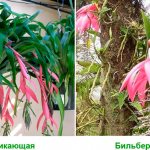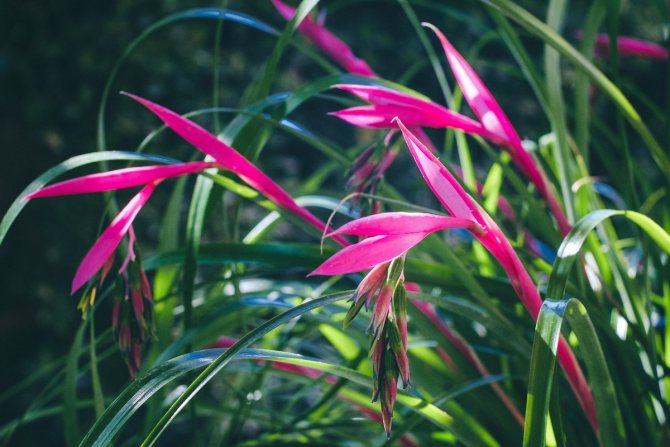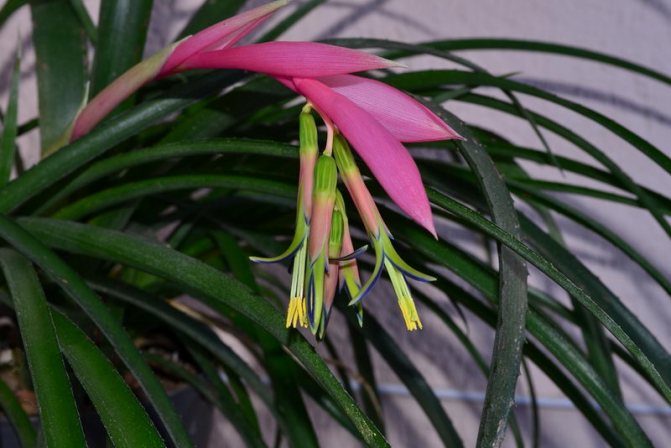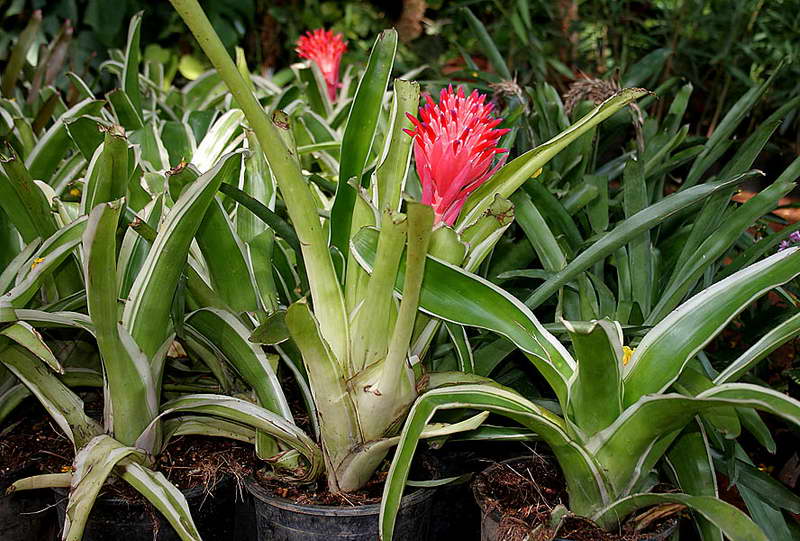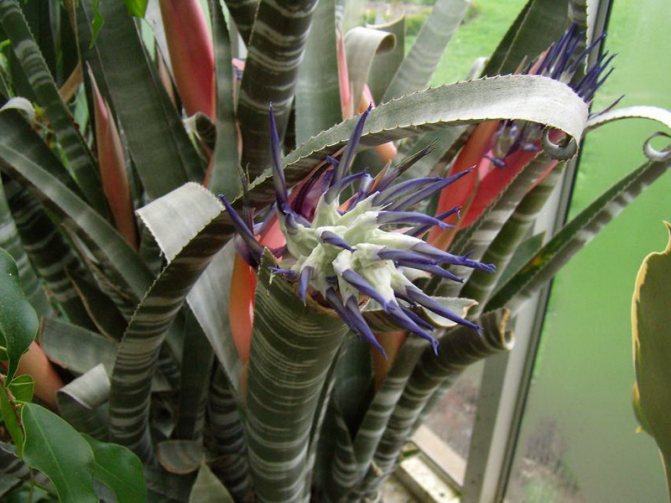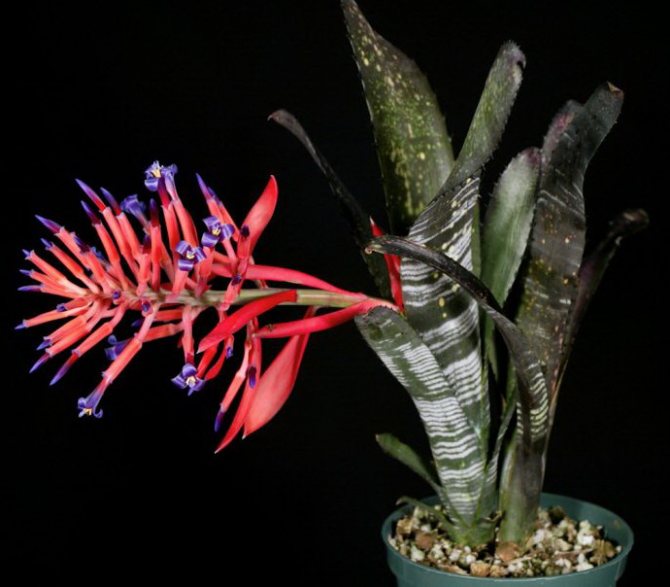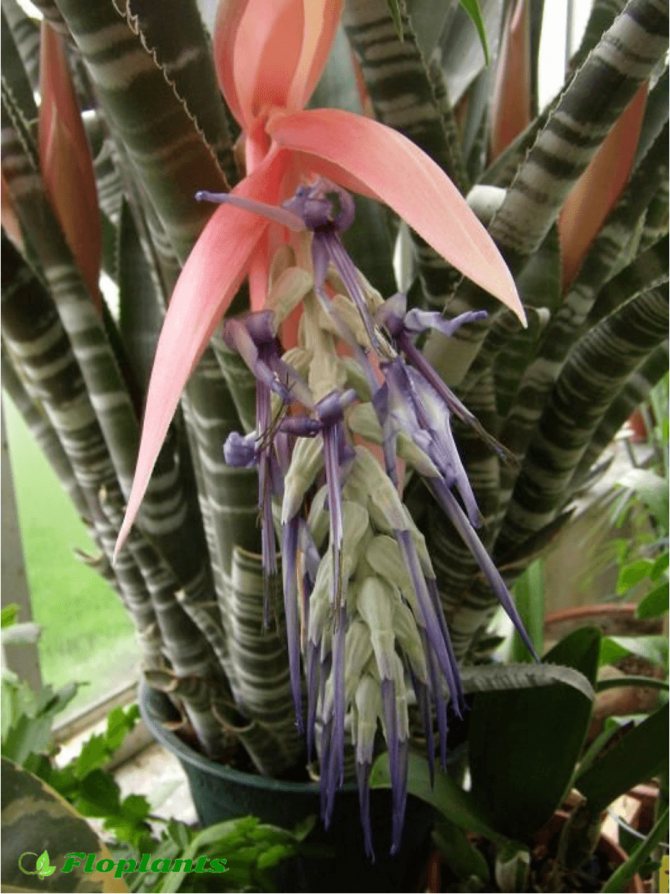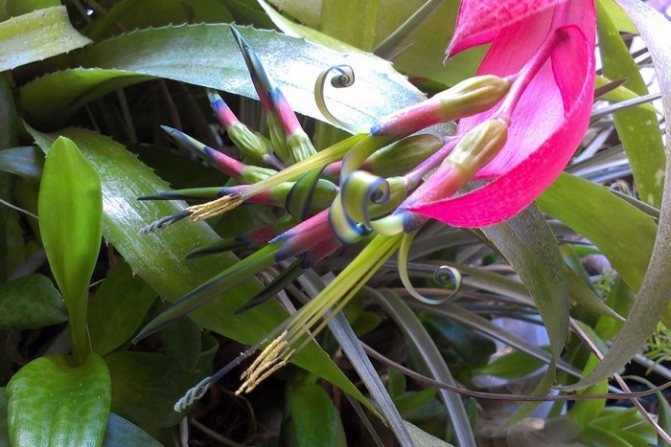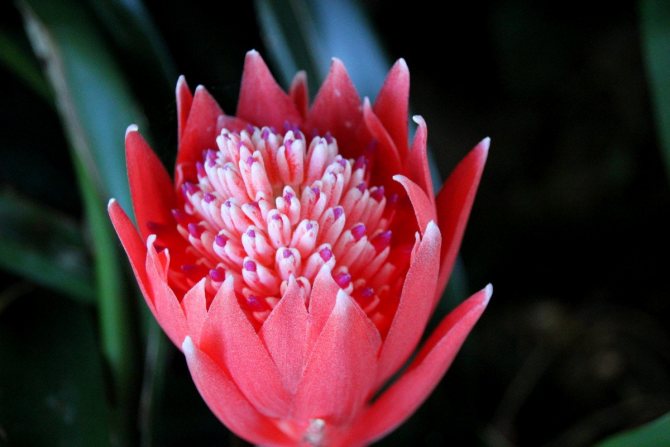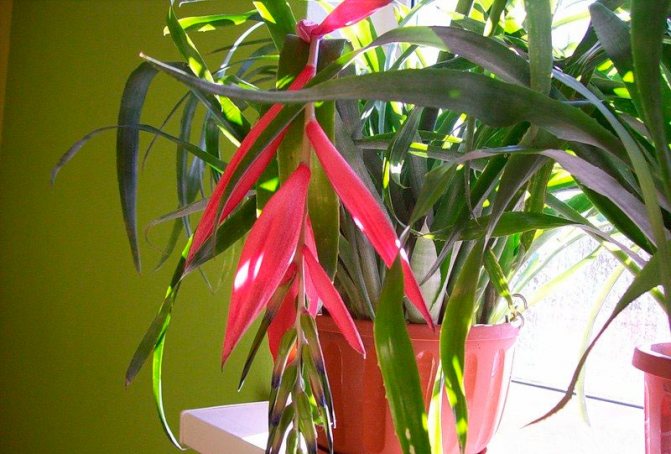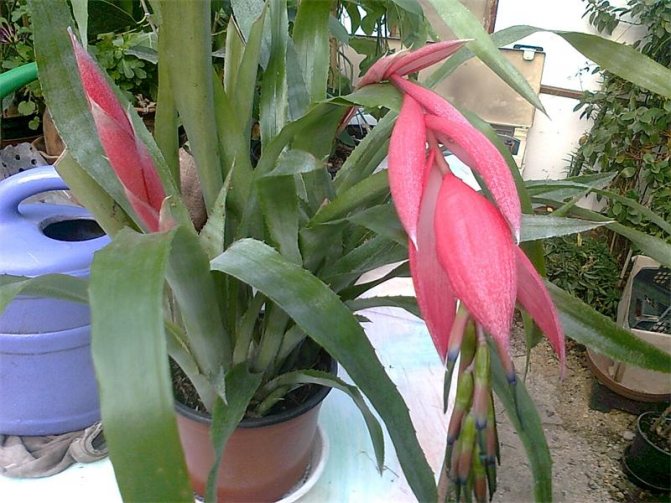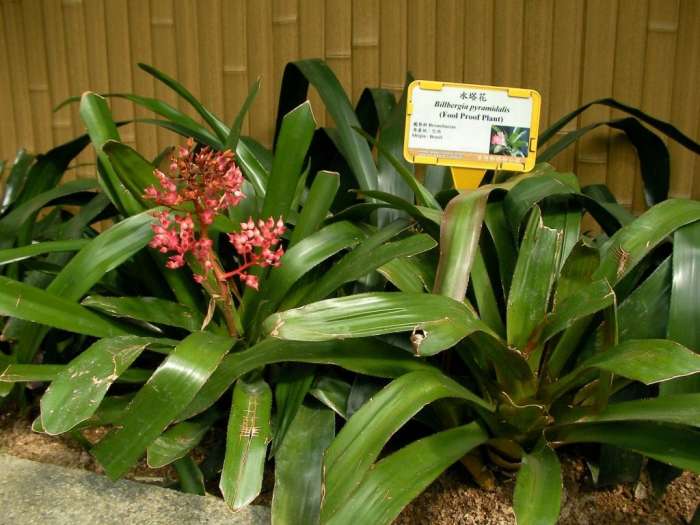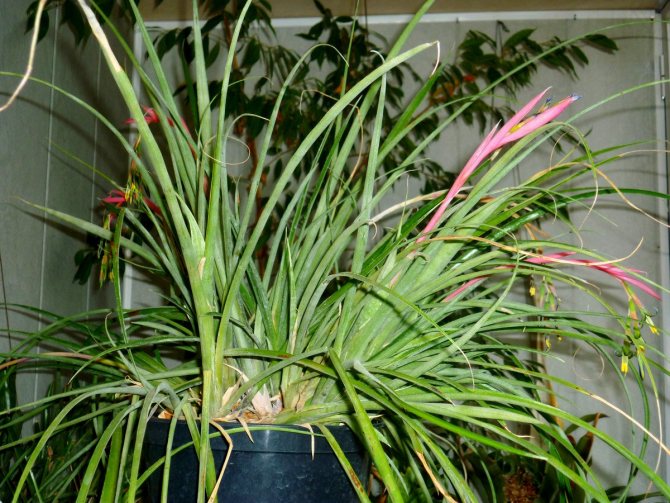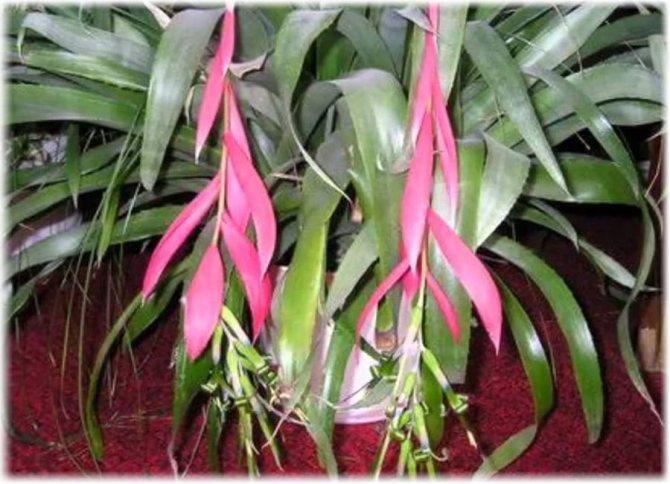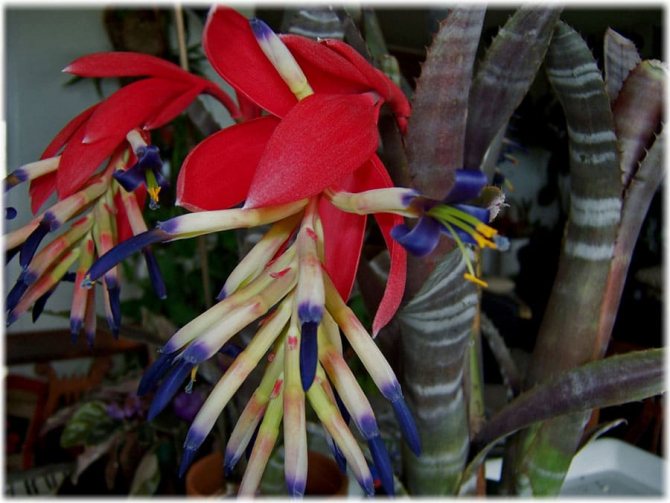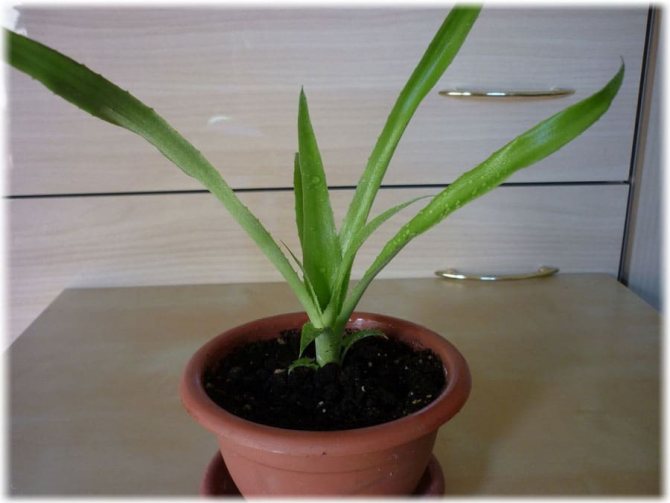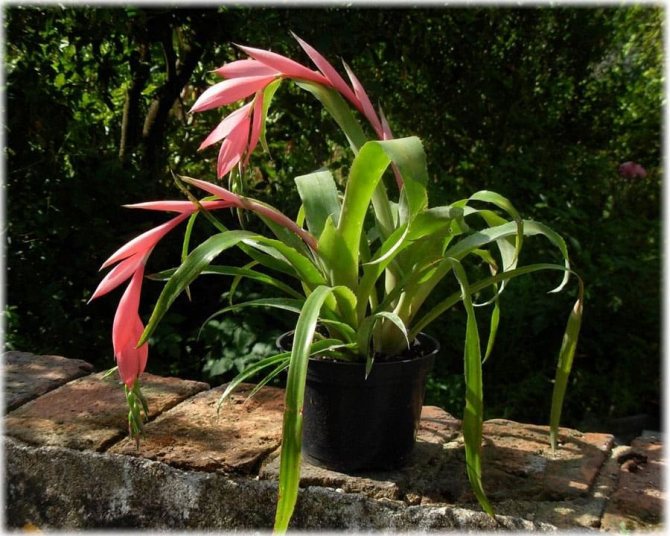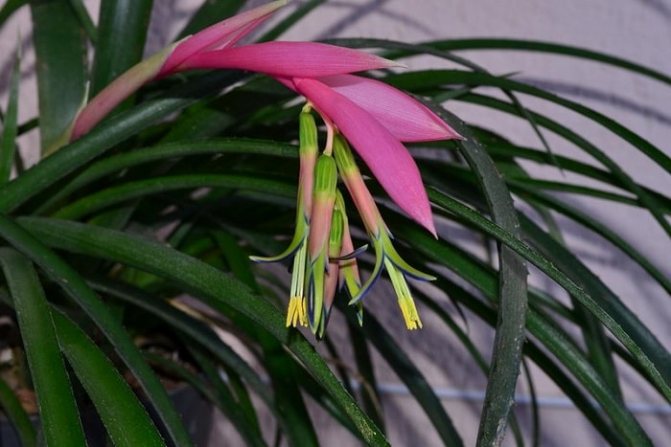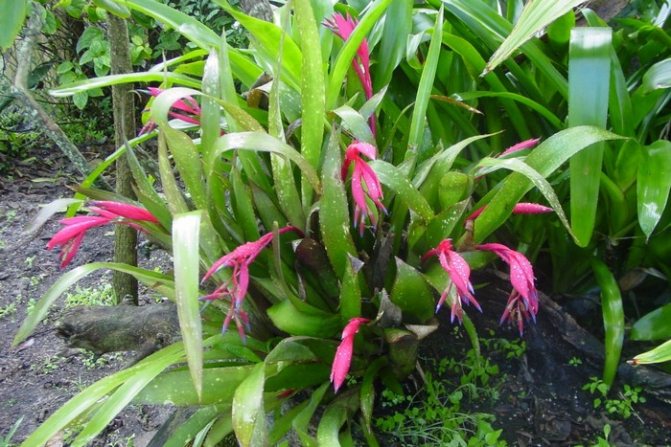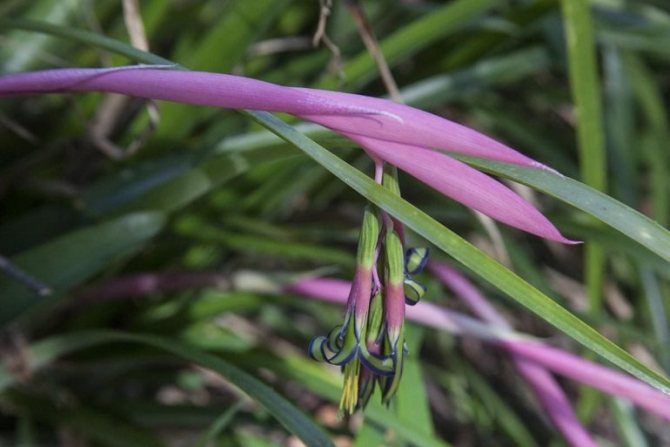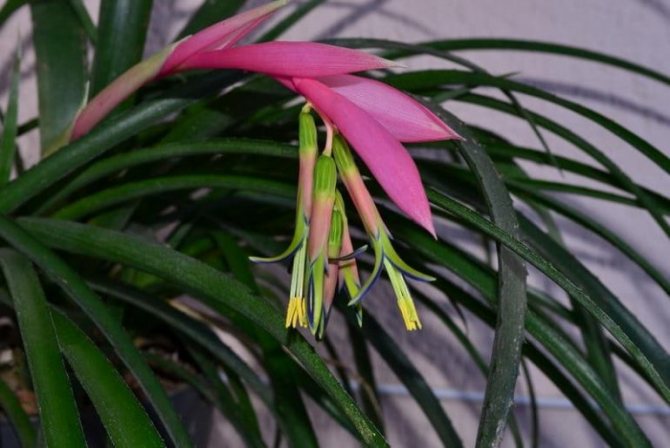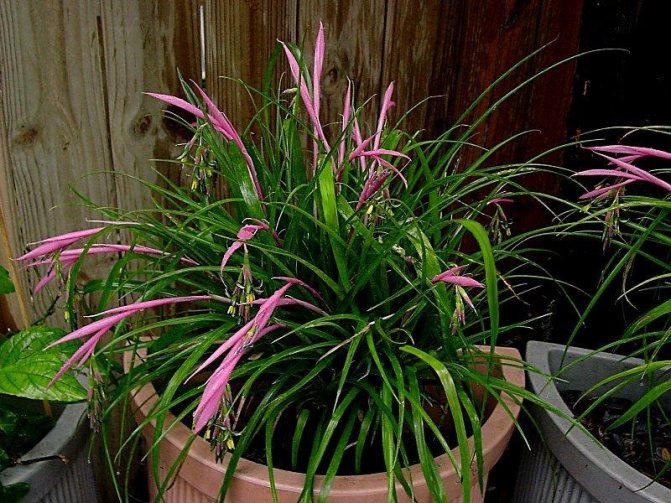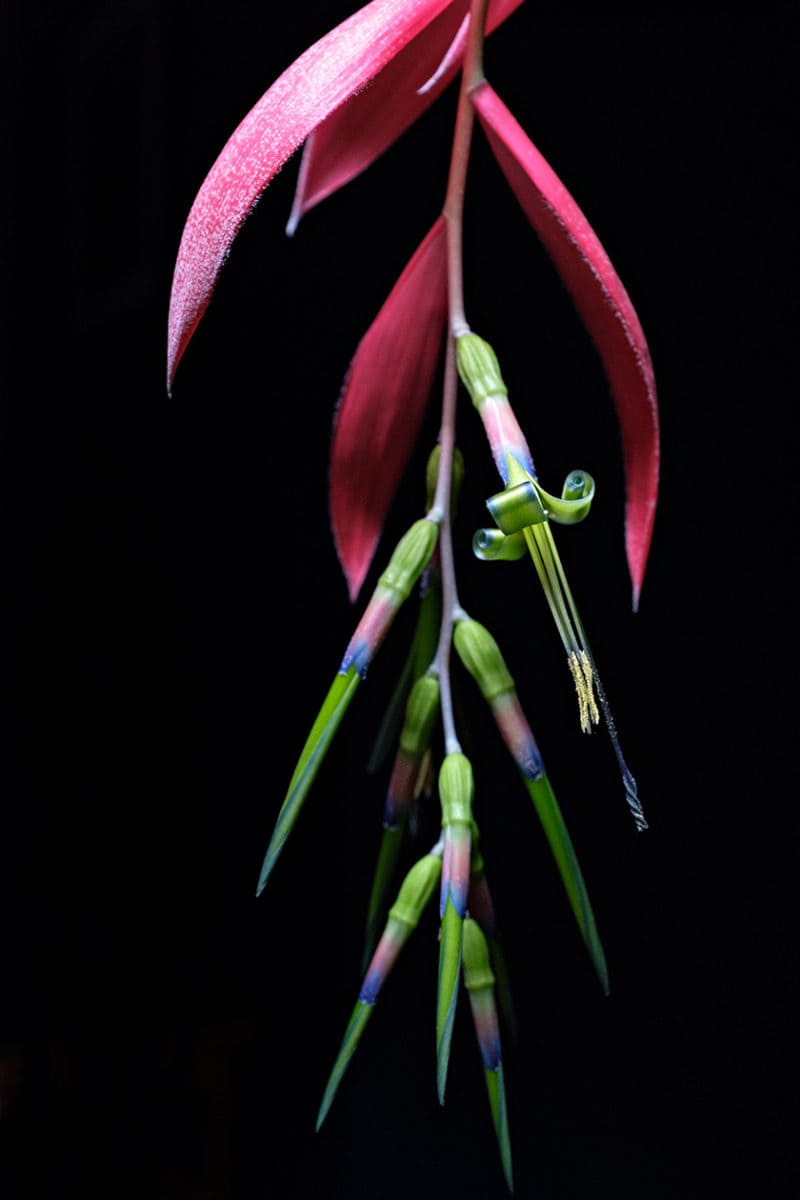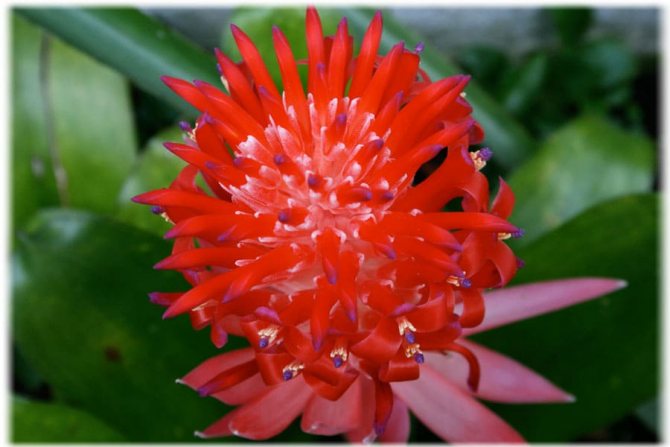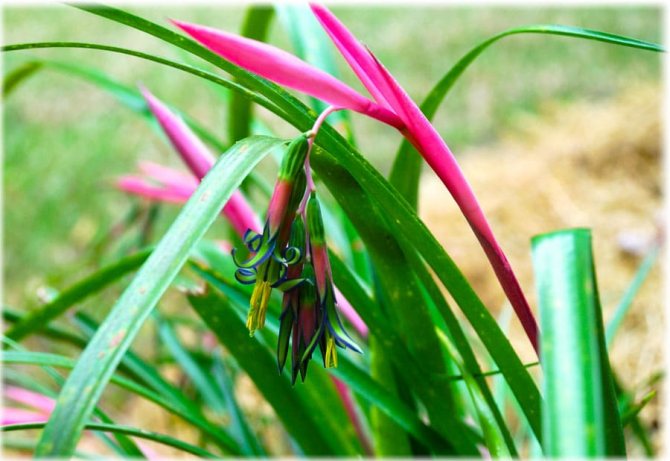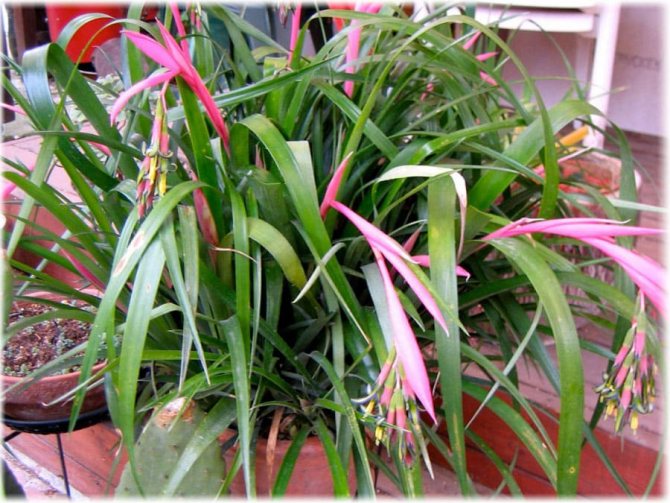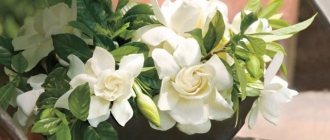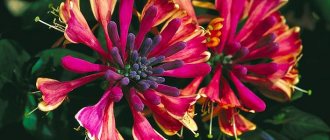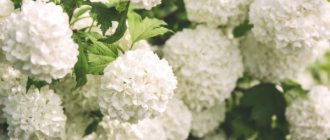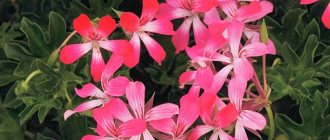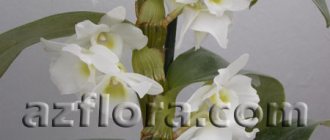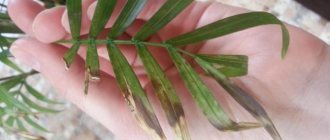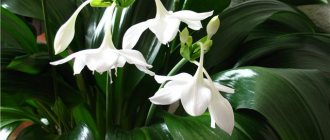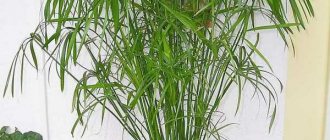Genus bilbergia is directly related to the bromeliad family. It unites about 60 species of various epiphytic and terrestrial plants. This plant is native to the subtropical regions of South and Central America, where droughts are frequent and temperatures can change dramatically during the day.
Due to prolonged droughts, this plant has formed a loose tubular leaf rosette, the purpose of which is to store and collect liquid. Linear, belt-like leaves are very rigid and have small denticles or spines at the edges. There are species, on the surface of the foliage of which there is a waxy bloom of a gray color, which protects bilbergia from moisture evaporation.
This plant becomes the most beautiful during flowering, which is observed twice a year, namely, in the spring and autumn. Flowers of various colors are attached to long peduncles growing directly from the center of the rosette of leaves. There are also large bracts of a rich color (often red or pink), they are collected in drooping inflorescences in the form of an ear.
The plant has new creeping lateral underground or aboveground shoots all the time, and young leaf rosettes are formed at their ends. At the end of the flowering period, the mother's outlet dies off, and in the new season, already young plants begin to bloom. Gradually expanding, Bilbergia can form a very large colony, which will consist of many "offspring".
Indoor conditions are most often grown drooping bilbergia (Billbergia nutans), also called "Queen's Tears". The plant reaches a height of 35–40 centimeters and has a green leaf rosette. The peduncle together with the inflorescence is 20-30 centimeters long, and it is painted pink. In half-open, light green flowers, the tips of the petals are painted in purple. The plant stands out with bright pink bracts.
And it is also very popular zebra bilbergia (Billbergia zebrina), which is also very popular with bromeliad growers. This is a fairly large plant. So, the leaves, which have a spectacular color, reach 80 centimeters in length. They are olive green and have wide, transverse, silvery stripes. It also has blue flowers and deep red bracts.
There are other species that grow indoors.
Bilbergia (Billbergia) - types of photos and growing at home
A plant from the Bromeliad family, it unites about 60 species growing in places with sharp temperature fluctuations and a pronounced dry season.
- Homeland: Brazil, Peru.
- Illumination: bright diffused light.
- Content temperature: summer - +22 + 28 ° С, winter - +14 + 18 ° С.
- Watering: in summer - regular in the outlet of leaves, in winter in the soil once a week.
- Growth rate: medium.
- Reproduction: seeds, offspring.
- Transfer: after flowering.
These are mainly epiphytes, forming a long tubular rosette of leaves for the accumulation of water. Leaves are leathery, yellow, variegated or monochromatic. From oblong-triangular to narrow-linear in shape, pointed at the apex and on 2 sides covered with small scales.There are thorns along the edges of the leaf blades. The flowers are brightly colored, with petals and arranged in a spiral or rolled into a tube, in paniculate or racemose inflorescences, similar to ears. The inflorescence leaves are brightly colored and very large. The fruit of Bilbergia is a berry.
Thanks to the constantly growing side shoots, the plant forms a large bush, consisting of numerous individual rosettes, reaching a height of 50-60 cm.
Growing problems
Deviations in the rules for caring for plants lead to difficulties in growing them. Let's dwell on the most common of them:
- Poor lighting contributes to the formation of decaying rosettes, and too bright - the appearance of brown spots on the leaves.
- The tips of the leaves dry out and turn brown when irrigated with hard water or when it stagnates in a funnel.
- The result of waterlogging of the soil is a gradual dying off of the outlet without flowering. If it occurs after flowering, then this is absolutely natural.
- In a plant affected by pests, the leaves turn yellow and die off.
But what if the bilbergia does not bloom?
One of the possible reasons is poor lighting and poor watering. It is enough to move it to another place, to carry out regular spraying on summer days.
Lack of minerals in the soil is the second reason. The way out of this situation is a transplant with a soil replacement or top dressing.
Useful advice from florists. Cut the apple in two and place them on top of the substrate. Cover the bush with a package. Under such conditions, ethylene is released from the apple, which accelerates flowering.
Bilbergia - plant care and maintenance
Bilbergia are unpretentious and much easier than other indoor plants to tolerate drafts and dry air. Bilbergia care and maintenance involves placing the plant in a shaded or bright place, but not under the influence of sunlight.
A soil mixture of humus, leafy earth, high peat and river sand in equal proportions is best suited. It is also recommended to add chopped sphagnum moss to the soil.
In spring and summer, the substrate should be constantly moist, but not waterlogged. In winter, it is enough to water once a week, allowing the earthen coma to dry out slightly. For irrigation, you need to use only soft and settled water at room temperature. You can water by pouring water into the funnel of the leaves of a plant with a tight rosette, and at temperatures below + 20 ° C and after flowering, you need to moisten the substrate.
The optimum temperature for keeping in the spring-summer period is +24 + 28 ° С. In autumn, it is necessary to smoothly lower the temperature to + 18 + 20 ° C. In the period from October to February, variegated forms must be kept at + 16 + 18 ° C, and forms with green leaves + 14 + 16 ° C and always in a bright room. Keeping at temperatures in winter below +10 +12 ° С will lead to disease or death of the plant.
Top dressing is carried out from the beginning of spring to the end of summer at intervals of 1 time in 2 weeks with special fertilizers for bromeliads or half a dose of fertilizers for flowering indoor plants.
Transplantation is carried out annually after the flowering period into a substrate of leaf, humus, turf, peat soil and river sand (1: 1: 1: 1: 0.5).
Reproduction is carried out using seeds and side shoots that have reached a length of at least 15 cm.
Bilbergia, when grown, is disease resistant with proper care and maintenance. Can be damaged by pests: spider mites, aphids, scale insects and mealybugs. Control measures: remove pests with a sponge with a soapy solution, and in case of severe damage, it is necessary to treat with karbofos or actellik, a solution of 15-20 drops per 1 liter of water.
Important content rules
Since Bilbergia drooping is more often grown at home, most of the recommendations for cultivation relate to it. Although the general rules apply to all plants.The features of other species are mentioned separately.
Lighting
Choosing the right place for bilbergia is the basis for long flowering. You can place it on the southwest or southeast windows. In such a place, good lighting is provided, there is little direct sunlight.
Although she can adapt to artificial lighting. Even the rays of fluorescent lamps instead of solar ones are enough for her. This perennial is often used to decorate the interior in the back of the room.
Comfortable temperature for bilbergia
The optimum temperature range is 12-25 ° C. To stimulate flowering, the ambient temperature is reduced by 2-3 ° C, and at the time of the transition to flowering, it is raised to 25 ° C.
Interesting to know. Bilbergia can withstand short-term temperature drops of 2-4 ° C.
In warm weather, she will like to be outside or on the balcony, but not in the sun.
Staying outdoors in a shaded area improves leaf coloration and stimulates lush bloom. Direct rays of the sun can change the color of the leaves from olive green to reddish. In the sun, its leaves turn yellow and fade.

Bilgeria before flowering
She is not afraid of drafts. I like frequent airing. The only requirement is that it must be protected from strong winds and precipitation. Sharp temperature changes are undesirable.
Watering
In summer, bilbergia needs abundant watering. Water is poured directly into the outlet. However, it is important to ensure that the funnel always contains fresh water and not stagnant water. It needs to be replaced periodically - monthly.
In the autumn and winter periods, watering is reduced.
Attention! After the flowering of bilbergia, water should not be poured into the funnel in order to avoid decay. When the room temperature drops below 20 ° C, it is recommended to drain the water from the funnel, and water it directly into the ground.
Stagnant water leads to dampness and decay of the shoots. They become soft and slippery.
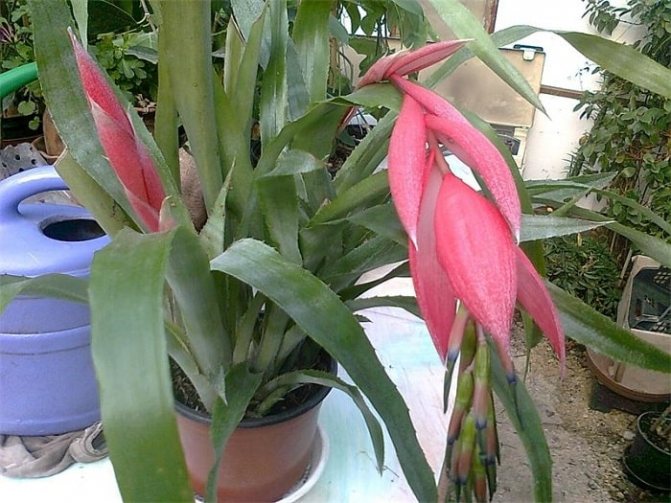

Watering
Her water requirements are the same as for other indoor flowers. She must be:
- defended;
- snowy or collected after rain;
- room temperature.
Watering should be carried out as the soil dries up to 2-3 cm in depth. In cool rooms, one watering per week is sufficient.
There are varieties of bilbergia without a pronounced rosette of leaves. Adult bushes have several outlets, which makes watering difficult and lengthens the procedure. Then they are watered directly into the soil.
Humidity
Bilbergia does not need high humidity. Spraying is carried out in the summer. She really likes this procedure.
When it blooms, spraying is replaced by installing pallets filled with wet pebbles, moss, expanded clay. This helps to avoid water droplets getting on the petals of the flower, prevents stains on them.
The bottom of the pot should not touch the water.
How to feed bilbergia
The unpretentiousness of this plant is also manifested in top dressing. Supplement it once with a liquid fertilizer containing guano immediately after flowering. In addition, at the time of spraying, a small amount of liquid fertilizers is added to the water. Such dressings are carried out 1-2 times a month on the leaves and at the root.
Fertilizers prepared specifically for bromeliads are on sale. Suitable for flowering indoor plants. It is not recommended to use universal fertilizers - excess nitrogen is detrimental to bilbergia.
Practitioner advice. It is better to withstand the concentration of dressings weaker than those indicated in the instructions. Usually the rate is reduced by half.
The interval from the initial stage of active growth to the end of flowering is the time of fertilization. From October to February, the plant is not fed or it is done very rarely - once every 1.5-2 months.
Bilbergia drooping (Billbergia nutans) or Queen's Tears
An epiphytic plant that forms narrow-funnel-shaped leaf rosettes in the form of bunches.With a length of 30-70 cm, leathery leaves are smooth above and with small thorns along the edges, dark green in color, and covered with small gray scales below.
If the plant is placed in a brighter place, the color takes on a pinkish-bronze tint. Bilbergia drooping has a curved and very thin peduncle. Erect inflorescence leaves are lanceolate, tiled, pointed, pink in color. A simple loose inflorescence, with short bare twigs bearing several flowers. Small bracts grow together with pedicels. Flowers are sessile or on a short pedicel, erect or deviating. Sepals are obtuse, elliptical, 1.5 - 2 cm long, pink, and dark blue along the edge.
The linear petals are obtuse, 2 times longer than the sepals, pale green with a yellow-blue edge and 2 large serrated scales at the base, and the stamens are equal in length to the petals. The fruit is a berry.
Decorative use
Alocasia is a valuable decorative leafy plant. Due to the fact that most species do not tolerate even short-term negative temperatures, in our latitudes it is used as an indoor or greenhouse plant.
Alocasia odorous
In countries with warm, humid climates, it can and is often used for garden and park design.
Caution: Some species have edible rhizomes (but most species have poisonous crystals in the rhizomes that cause numbness and swelling of the tongue and throat).
Bilbergia magnifica
A plant with a few, almost erect, collected in a tubular rosette leaves up to 70 cm long and up to 8 cm wide. The leaves are very hard, densely covered with dark twisted thorns along the edges, with a rounded tip in small thorns that sharply turns into a short acumen. The upper side of the leaves is dotted with small white scales arranged in strips of different widths. Drooping thin peduncle with a thick white powdery bloom up to 25 cm long.
The inflorescences are wide, thin, elliptical, pointed, pink in color. The inflorescence is simple, loose, up to 30 cm long, with a strongly pubescent axis. Bracts are well developed, the lower ones are similar in shape and size to the inflorescence leaves. Sepals at the apex are obtuse, elongated or oval, asymmetric, thin, up to 12 mm long, slightly drooping. Flowers are sessile, rejected. In Bilbergia magnificent petals are linear, up to 7 cm long, spirally twisted during flowering, yellowish-greenish, and blue at the top. The anthers of the stamens are blue. Ovary densely pubescent with dark vertical stripes and fruits - berries.
Errors in agricultural technology
A bright epiphyte is not picky about the conditions of care, troubles arise with regular violations of the rules. Waterlogging often causes the death of seedlings. Wet sour soil is an excellent environment for the formation of fungi and the death of roots. The first year, young specimens are provided with easy drying of the soil; to improve the supply of oxygen, the top layer is regularly loosened.
The loose rosette of the bilbergia flower warns of a lack of lighting. The plant loses its decorative effect, looks sloppy, resembling ordinary grass. If the agricultural technique is not corrected at home, then the exotic beauty does not form buds. A phytolamp or moving the flowerpot closer to the window will help correct care errors.
Dark spots on the foliage arise from the sun, so it is better to hide the bush from aggressive rays. Shading with a curtain, gluing a sheet of food parchment to the glass is suitable. If brown tips appear on the plates, then this is the result of moisture stagnation in the funnel or irrigation with hard water.
Bilbergia pyramidal (Billbergia pyramidalis)
Originally from Southeast Brazil and the Antilles, where it grows at an altitude of 500-1700 m above sea level. Bilbergia pyramidal is a terrestrial plant with a tubular-funnel-shaped rosette of leaves. Leaves are hard, broadly linear, from 40 to 100 cm long and up to 6 cm wide, pointed to the top or rounded with a sharp point, with finely serrated edges and wide white stripes below.
The erect and strong peduncle is densely white-tomentose, and the inflorescence leaves are almost erect, tiled, pointed, lanceolate-elliptic, pink and crowded in the lower part of the inflorescence. A simple inflorescence is straight or almost straight, corymbose or short-cylindrical, densely pyramidal, up to 15 cm long, densely white-tomentose. Small ovate and pointed bracts. Flowers with thin and short pedicels. Sepals slightly accreted at the base are asymmetric, elongated, obtuse or with a short cusp of pale red color, 15-18 mm long.
Petals are lingual, obtuse, bright red, not much longer than stamens, with 2 fringed scales at the base. The ovary is almost cylindrical. It can bloom 2 times a year. Flowering periods: July-August and February-March. The fruits are berries.
Location:
bilbergia are very light-requiring, prefer bright diffused light. On hot summer days, shading from the midday sun is required. East and west windows are best suited. It can grow near the northern window, but it does not bloom. It is not afraid of drafts, loves a lot of fresh air, therefore it is recommended to take it out into the garden in summer, protecting it from precipitation and direct sunlight - this stimulates flowering in young plants.
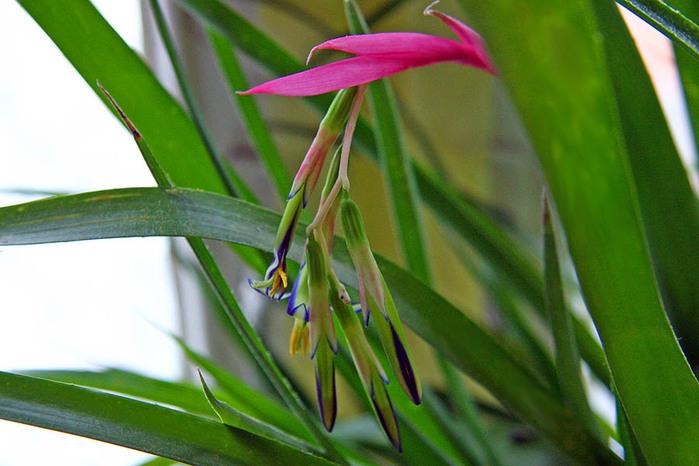

Description of the bilbergia flower (with photo)
Described in 1823, the bilbergia flower is named after the Swedish botanist Wilberg (1772–1844); contains 56 species of epiphytic, terrestrial or stony substrates, diverse in appearance, common in Southern Mexico, Central America, West Indies, Venezuela, Bolivia, Colombia, Guiana, Peru, Brazil, Uruguay, Paraguay, Northern Argentina.
Bilbergia is an epiphytic plant belonging to the bromeliad family. In the wild, it is found in the rainforests of America. Grown indoors and in greenhouses.
The plant consists of narrow herb-shaped leaves that are collected in funnel-shaped rosettes. Bilbergia has leathery, linear, ribbon-like leaves. In some plant species, the edges of the leaves are finely serrated. Bilbergia blooms constantly and reproduces well.
During flowering, bilbergia forms drooping inflorescences, which have flowers of green-purple color with dark pink bracts. A hybrid of bilbegia with orange bracts is also on sale. If bilbegia was kept in a warm room in winter, then flowering begins at the very beginning of spring, with cold wintering, bilbergia begins to bloom at the end of summer.
Look at the bilbergia flower in the photo, where all the characteristic features are visible:
Genus Bilbergia (Billbergia)
has more than 60 species of epiphytic and terrestrial herbaceous plants of the bromeliad family. Grows wild in tropical and subtropical regions of Central and South America. At home, they have to withstand a rather long cool period, and sometimes droughts or frosts occur. Of all bromeliads, bilbergias are considered the most unpretentious to care for.
Bilbergia drooping flower or "Queen's tears"


Bilbergia drooping flower or "Queen's tears"
Types of bilbergia with descriptions
The following are popular types of bilbergia with descriptions and photos that illustrate the external attractiveness of the plant.
Bilbergia pale-flowered -Billbergia pallidiflora, (L.) Fs.
In culture since 1854. Distributed from Mexico to Nicaragua, in subtropical forests; at altitudes from 100 to 1400 m above sea level.An epiphytic or plant growing on stony slopes up to 70 cm tall, with few leaves collected in a dense tubular rosette. Blooms in January.
Leaves up to 70 cm long, 4.5-6 cm wide, linear, lingual, with a pointed apex; at the edges with light-colored thorns 3 mm long; top and bottom covered with grayish-white scales; very tough; green.
Peduncle curved, 7 mm in diameter, with dense white pubescence. The leaves on it are large, up to 15 cm long, lanceolate-oval, pointed. The inflorescence is spicate, multi-flowered, densely pubescent, up to 20 cm long. Bracts are several times smaller than the calyx, rounded. Flowers 8-10 cm long, widely spaced, sessile, straight. Sepals are free, asymmetric, 0.9–1.2 cm long, oval, elongated, pointed, leathery. Petals are also free, up to 4.5 cm long, greenish-yellow, linear, pointed, twist outward during flowering; at the base with two large scales.
The fruit is a berry.
Bilbergia magnificent - Billbergia magnifica, L. B. Sm.
Widely distributed in Southeast Brazil (state of Espirito Santo), Paraguay, in subtropical and tropical forests. Blooms in June - August.
Leaves are few, very long (up to 70 cm with a width of 3–8 cm), almost erect, collected in a tubular rosette. Very hard, with dark spines along the edges and a pointed apex, on the outside they are covered with small white scales arranged in stripes of different widths.
Flowers are collected in a simple loose spike-shaped drooping inflorescence up to 20-30 cm long, with a strongly pubescent axis. Peduncle 26 cm long, curved, drooping, thin, with a thick white powdery bloom. The leaves on the peduncle and the bracts of the lower flowers are large, oval or elongated, somewhat asymmetrical, slightly pubescent, pointed; pink. The bracts are well developed, in the lower flowers they are similar in size and shape to the covering leaves.
Flowers up to 8 cm long, sessile, rejected. Sepals are free, up to 1.2 cm long, obtuse at the apex, oval or oblong, somewhat asymmetrical, slightly pubescent. Petals are also free, linear, up to 7 cm long, spirally twisted during flowering, yellowish-green, blue at the top. The anthers are blue.
A known variety is var. acutisepala, in which sepals are pointed, with a bent sharp tip, leaves with pale green thorns 1.5 mm long.
The fruit is a berry.
Bilbergia zebra-Billbergia zebrina, (Herb.) Lindl.
In culture since 1846. Distributed in Southeast Brazil, Paraguay, Uruguay, North-Eastern Argentina, in lowland subtropical and tropical forests, settles in large groups on trees and shrubs. Epiphytic plant up to 1 m tall. Blooms in June, July.
Leaves, up to six in number, are collected in a dense, tubular rosette. Curved, up to 70 cm long, 8 cm wide, linear, lingual; at the apex with a pointed tip; at the edges with widely spaced spines up to 4 mm long; covered with whitish scales; very tough; green, usually with white stripes or spots.
Peduncle curved, densely pubescent. The leaves on it are large, densely located at the base of the inflorescence; lanceolate, whole-edged, membranous; pink. Inflorescence 15–40 cm long, drooping, multi-flowered, spike-shaped, with a white powdery bloom. Bracts are small, oval-lanceolate, slightly furrowed, densely pubescent, pink. Flowers are sessile, almost straight, 7–8 cm long. Sepals are loose, slightly asymmetrical, up to 0.8 cm long, narrow, truncated, with a white powdery bloom. Petals are also free, up to 6.3 cm long, linear, spirally twisted during flowering, straw yellow; with two fringed scales at the base.
The fruit is a berry.
Bilbergia greening -Billbergia chlorosticta, Saund.
In culture since 1875. Distributed in southern Mexico, Honduras, Guatemala, Brazil (Bahia state), in tropical forests.Epiphytic plant 40–80 cm tall, with few (5–7) leaves, collected in a dense tubular rosette. Grows in rocky areas, in tropical forests along rivers, up to 150 m above sea level. Blooms in December - January.
Leaves 30-60 cm long, 3-4 cm wide, linear, lingual, rounded or pointed at the apex; serrate at the edges; tough; on the upper side - dark green, on the lower side - red, with few scales and whitish spots.
Peduncle curved, thin, with a white powdery bloom. The leaves on it are large, lanceolate, pointed, carmine-red. Inflorescence up to 12 cm long, drooping raceme of 7-17 flowers, also with a white powdery bloom. The bracts of the lower flowers are large, similar to the leaves of the peduncle, the rest are small. Flowers 5–6 cm long, with thin pedicels 0.5–1 cm long. Sepals are free, up to 2 cm long, asymmetrical, with a sharp point; red. Petals are also free, up to 5.6 cm long, linear, yellow-green, blue at the top; at the base with two fringed scales.
The fruit is a berry.
Bilbergia green-flowered - Billbergia viridiflora, L. B. Sm.
Homeland - the south of Mexico, Honduras, Guatemala. The plant is large, up to 100 cm tall, epiphytic or growing on rocky outcrops. Numerous (12–15) leaves, 60–100 cm long, 4–9 cm wide, linear, lingual, narrowed towards the apex, with a pointed tip; serrate at the edges, with spines 1–4 mm long; tough; green on the upper side, bordered on the bottom with a wide light stripe, with rare, barely noticeable scales, collected in a dense tubular rosette. Blooms in February, April, July.
The peduncle is almost erect or slightly drooping, equal in length to the leaves, thin, with a white powdery bloom that disappears as it blooms. Leaves on it are erect, tiled, 14 cm long, elongated-oval, pointed to the apex, with a short pointed tip, finely serrate at the edges; thin; red, covered with scales. Inflorescence is loose, racemose, 20-50 cm long; its axis is thin, bare. Bracts linear-triangular, pointed, up to 2 cm long, covered with scales; thin, filmy. Flowers on pedicels up to 5 cm long, glabrous. Sepals are free, up to 2.1 cm long, lanceolate or triangular, pointed, asymmetrical. Petals are also free, 4–5 cm long, linear-lanceolate, pointed, green, slightly bend back during flowering; at the base they bear two scales.
The fruit is a berry.
Bilbergia pyramidal -Billbergia pyramidalis, (Sims.) Lindl.
Homeland - Southeast Brazil, Antilles, Venezuela. Terrestrial plant. It grows at an altitude of 500-1700 m above sea level. Blooms in March and July - August.
Leaves (up to 13), form a tubular-funnel-shaped rosette, broadly linear, rigid, 40-100 cm long, 4-6 cm wide, pointed or rounded with a pointed tip at the apex, finely serrated edges, with indistinct gray stripes below. The inside of the vagina with a red spot.
In flowers, the peduncle is straight, strong, densely white-tomentose. The leaves on the peduncle are almost erect, pink, densely twisted at the base of the inflorescence. The inflorescence is straight or nearly straight, pyramidal, corymbose or short-cylindrical, not more than 15 cm long, densely white-tomentose. Bracts are very small. Flowers on short stalks. Sepals are fused, pale red; the petals are ligate, bright carmine-red, slightly longer than the stamens.
Known varieties:
Var. rubra (red) - red petals with a bluish tinge at the ends;
Var. concolor (single color) - the petals are entirely red. Known only in culture.
Bilbergia Sanders - Billbergia saundersii, Saund.
Bilbergia Sanders has bright red wide bracts and bluish tubular flowers, collected in a spike-shaped inflorescence. The original color of the leaves is variegated, with pink, white and green spots. After flowering, old rosettes of leaves die off and young leaves appear in their place. The decorative period lasts all year round.
Bilbergia euphemia - Billbergia euphemiae, E. Morren.
In culture since 1880. Distributed in Brazil (states of Bahia, Rio de Janeiro); in tropical forests or rocky slopes.Epiphytic or terrestrial plant about 30 cm tall, with few leaves forming a dense, narrow, funnel-shaped rosette. Blooms in March, May, December.
Leaves up to 30 cm long, 4.7 cm wide, linear; at the top with a small sharp tip; along the edges with spikes up to 1 mm long; leathery, tough; gray-green, with blurred transverse stripes.
The peduncle is curved, thin, red, with a white powdery bloom. The leaves on it are straight, large, lanceolate, pointed, whitish-red. Inflorescence is a raceme, 5-12 cm long, drooping, few-flowered, with a white powdery bloom; the axle is cranked-curved. The bracts of the lower flowers are large, the upper ones are small, densely pubescent. Flowers 5-6 cm long, on short pedicels, curved. Sepals are free, 1.2–1.8 cm long, narrowly oval, asymmetrical, with a slight acumen, densely pubescent. Petals are also free, up to 4.2 cm long, linear, obtuse, purple or dark blue at the top, pale green at the bottom; at the base with two fringed scales.
There are known varieties of ephemia:
Hapo-flowered (var. Nudiflora) - leaves are green or with pale transverse stripes;
Purple (var.purpurea) - purple leaves.
The fruit is a berry.
Characteristics of the Bilbergia plant
Bilbergia flower is an evergreen perennial epiphyte from the Bromeliad family, named after a famous Swedish botanist. Representatives of the species develop in Brazil, Bolivia, Argentina and Mexico. The culture prefers to live on the bark of trees, although it is sometimes found at the foot of the trunks. Loves bright diffused light, natural shading.
In Bilbergia, rigid leaves-belts with sharp thorns at the ends are collected in lush rosettes, in which moisture accumulates. Bright spiral inflorescences of a red or cream shade from afar resemble a candle flame. After the petals fall, a berry with seeds is formed. Most of the surface is covered with scaly plates.
The bilbergia flower, which is not capricious in leaving, is actively growing, occupying empty areas. Lateral rosettes develop into independent plants. The height of the specimens does not exceed 60 cm. The first buds are tied in the third year of life. After flowering, the mother bush gradually dies off, leaving room for the young.
In the wild, an exotic guest can withstand prolonged drought, minor temperature fluctuations. The foliage collected in a socket, rigid in structure, helps to collect moisture "for a rainy day". The beauty undemanding to care at home adapts to the microclimate of the apartment and the bright sun of the metropolis.
Bilbergia flower is one of those few plants that do not need constant lighting. She tolerates even the most shaded areas of the apartment quite well. Strongly bright lighting is detrimental to this delicate flower. Therefore, it must be placed in places with diffused light - there Bilbergia feels as comfortable as possible.
The temperature regime also does not play a special role for the normal life of the plant. During the period of active growth, the optimum temperature will be 18-30 ° C. The main thing is that it should not be lower than 13 ° C.
In the warm season, bilbergia can be taken out into the garden or on a flower bed. Fresh air will encourage vigorous growth and flowering. Green leaves and colorful inflorescences will surprise you with their brightness.
Watering and fertilizing
In order for bilbergia to feel comfortable, it is necessary to constantly maintain soil moisture. The flower does not tolerate dry and waterlogged soil. It is necessary to water the plant after the upper substrate dries up by 2 cm. Watering the flower is also done in the leaf outlet. But this method is very risky - if the plant is kept in a cool room, it can rot.
Bilberia Windy
In cold periods of the year, it is necessary to reduce the watering of bilbergia to once every 7 days. The soil should remain slightly dry.If the plant is kept at temperatures above 25 ° C, the leaves should be sprayed regularly.
It is necessary to feed the flower all year round, even during the dormant period. In autumn and winter, when bilbergia is actively blooming, the flower is fertilized once a month. During the warm period - once every two weeks. Top dressing must be chosen specifically for bromeliads, otherwise the plant may die from an excess of nitrogen.
After the cessation of flowering bilbergia, seeds appear on the peduncles. In order to grow beautiful plants from them, you need to follow some rules:
- seeds must be sown fresh - this guarantees high germination;
- the soil can be made by mixing parts of peat, humus, sand, leafy soil and moss.
- after sowing, sprinkle with wet sand on top;
- the sown containers must be placed in a darkened place, maintaining the humidity and air temperature at 26 ° C;
- sprouts will appear in a month. They can be seated in separate containers and covered with foil.
This breeding method is the easiest. With each transplant, you need to divide the bush into several parts. The larger the divided bush, the greater the chances of it taking root.
Bilbergia also reproduces well by dividing daughter flowers. Not too small sprouts are neatly broken off and rooted in a pot covered with foil. The soil can be made by mixing parts of peat, humus, sand, leafy soil and moss.
Video reproduction of bromeliad plants
With proper care, this undemanding plant will delight you for a long time with its abundant flowering throughout the year.
All problems with the cultivation of bilbergia are associated with a violation of the conditions for caring for a flower, while the following troubles can be distinguished:
- with a sunburn, pale brownish spots appear on the foliage, you will need to rearrange the plant away from direct sunlight or arrange shading;
- if you water the bilbergia with hard water or moisture stagnates in the funnel of the leaf outlet, then the tips of the foliage will turn brown;
- when the plant has not yet bloomed (and we remember that when the inflorescence withers, the rosette dies) and began to show signs of withering away, then the soil in the pot was overmoistened;
- the leaf rosette becomes loose and falls apart in all directions when there is not enough illumination of the bilbergia.
Damage by harmful insects also occurs: scale insects, mealybugs, aphids or spider mites. These pests settle on leaves, which begin to turn yellow, deform and die off. On the sticky sugary secretions of insects, a sooty fungus parasitizes. Therefore, it is necessary to carefully examine the flower and if the specified symptoms are noticed, then treatment with an insecticidal agent is carried out (for example, karbofos or actellik, 15-20 drops of the drug are taken per liter of water).
Indoor plant bilbergia drooping: photo and home care
Houseplant drooping bilbergia (Billbergia nutans, H. Wendl) - the most popular species, which is often called "Queen's tears" for beautiful drooping pink inflorescences, in which the flowers themselves are not decorative as well as bracts, reaching 30–45 cm in length.
Unlike Bilbergia Sanders, its leaves are green from light to dark, without spots or stripes. In the hybrid form, which is common in culture, the leaves are wider, and the inflorescences are much larger than in the drooping bilbergia. In bright light, they acquire a beautiful bronze color, belt-like, leathery, linear, fine-toothed.
The plant is decorative also during development, when a sharp pink cone rises from the rosette of dark green leaves. Each rosette produces one inflorescence in winter or spring.
Planted in a pot, drooping bilbergia grows rapidly, forming a dense bush, consisting of many tubular rosettes.Caring for bilbergia drooping at home includes standard agrotechnical measures: watering, loosening, fertilizing, transplanting.
Flowers are slightly decorative, greenish, half-open, hanging on short pedicels, decorated with pink bracts, inflorescences reach 30 cm, are formed at any time of the year.
Reproduction: propagates by dividing the bush into several parts or by tubular leaf rosettes separated from the mother plant.
Features: a beautiful plant, hardy to the conditions of keeping, but requires a lot of fresh air. In summer, it can be displayed on the balcony. For annual flowering, irrigation with fertilizer is necessary. It is necessary to transplant once every two years after flowering. Water is poured over both tubular sockets and the soil. It is recommended to keep at a temperature of + 19-22 ° C, but it can withstand even lower temperatures. In soil culture, it is recommended to use a mixture of peat, light turf and chopped moss, or peat alone. It works great in hydroponics and on ion exchange substrates. In an artificial soil environment, it grows without transplants and transshipments for two to three years, without requiring any fertilizers. You can use simple pots, flowerpots, boxes, ampli, etc. for growing. Perfectly decorates the premises. It grows superbly and blooms under fluorescent lamps for 4-5 years, turning into powerful spectacular bushes from uneven-aged outlets.
Bilbergia drooping - pink form (Billbergia nutans f. Rosea).
Appearance and structure: very similar to drooping bilbergia, but the plant is less compact, the leaves are narrower, gently curved, dark green, collected in narrow tubes. Flowers in graceful slightly drooping swaying inflorescences with bright bracts, have a green ovary, bluish inner petals (perianth), pale pinkish short sepals. The inflorescences consist of 7-9 flowers, which open gradually. Flowers (perianths) in inflorescences persist for a long time, cut off together with bunches of leaves, stand for a long time in water and form roots.
Look at the bilbergia drooping in the photo, where all its varieties are shown:
Bilbergia is a perennial evergreen
... The leaves are narrow and long, rather hard, colored or spotted, depending on the species and variety, collected in a rosette. In most species, the edge of the leaf blade is finely toothed. The flowers are collected in drooping ears, the bracts are large, bright, the color is varied. The flowering time depends on the growing conditions: spring is considered the norm, but at low temperatures it may not bloom until the end of summer. Adult specimens of Bilbergia constantly reproduce shoots, and over time, the plant grows strongly.
Bilbergia drooping flower or "Queen's tears"
Many types of bilbergia are very decorative and popular in indoor culture:
Caring for bilbergia at home (with photo)
Of all bromeliads, bilbergias are the most unpretentious. They do not require high air humidity, they are not afraid of drafts. Perfect for beginner gardeners.
With sufficient care, bilbergia at home grows well in a bright, warm room, the temperature in which does not fall below 18 ° C. In this case, the plant needs increased air humidity. Lighting should be sufficient, you can grow without sunlight, using LB lamps for 16 hours a day.
Bilbergia develops well in terrariums, in warm greenhouses. The plant is very beautiful and can adequately decorate a room, a large hall, a winter garden.
The plant can also be planted in the garden, but in a place protected from wind and sun. Under optimal climatic conditions, it is used for outdoor landscaping.
See how the care of bilbergia is carried out in the photo, which shows the basic operations for transplantation and reproduction:
Watering. Humidity is maintained moderate and higher, spraying is mandatory.Watering is sufficient, moderate in autumn. Like most bromeliads, bilbergia is watered directly into an outlet, but only if the air temperature is above 20 ° C; at lower temperatures, only the soil in the pots is moistened. For watering, you must use well-settled tap water at room temperature.
Temperature. Winter minimum 13 ° C. At lower temperatures (but above 0 ° C) it will not die, but it will grow or bloom worse.
Substrate. Can be grown not only in pots, but also on driftwood and bark blocks. In order to transplant or grow a young plant, it is recommended to use a soil mixture that consists of equal parts of leafy soil, pre-crushed pine bark, peat and dry cow dung with the addition of finely crushed charcoal and granular perlite.
Top dressing. Top dressing in the summer is carried out with a solution of mineral or organic fertilizers after two weeks (best of all with a liquid fertilizer containing organic matter).
Bloom. The first flowering can be expected in about three years. Some time after flowering, the rosette dies off and a new plant grows from a creeping stem or rhizome, which blooms in the next season. Older plants develop many narrow-funnel-shaped rosettes, which often bloom at the same time. It is recommended to cut the old rosettes 1-2 months after flowering.
Reproduction. Offshoots that appear around the old faded rosette. Separate them from the parent plant when they are halfway up. It is recommended to sprinkle the cut points with powdered charcoal.
Caring for bilbergia at home in the photo illustrates all the basic agricultural techniques from planting to fertilization:
Reproduction
For reproduction, side shoots are used, separated from the mother outlet. The size of such a shoot should be equal to half of the mother's socket. Otherwise, he will be stunted. Dry the cut before planting.
Planting the shoot in the ground is carried out according to the rules described in the previous section.
For faster rooting of children, they create conditions for a greenhouse - they wrap them with a cap made of a film or a plastic bottle. The cap must not touch the handle. A fence is made of sticks, and then wrapped in cellophane.
Practitioners advise that the temperature of the soil composition be 23-26 ° C. Therefore, they use the bottom heating method. The containers are placed above the battery or heated using special lamps.
Rooting usually takes place within a month. The appearance of new leaves in the center indicates that the process has taken root.
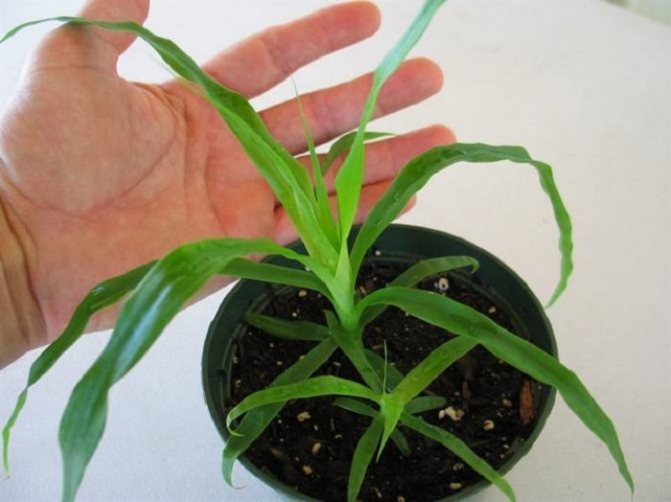

Reproduction by shoots
Flowering of these plants occurs after 2-3 years.
The second breeding method is dividing the bush into 2-3 parts. Such delenki adapt faster, grow actively, and bloom profusely even in the next season. The result is a large, attractive plant.
Finally, the third way to get a new plant is to grow it from seed. Step-by-step recommendations:
- Prepare the seeds, soak them in a manganese solution in advance, dry them.
- Sow in a moist peat and sand substrate. Cover with plastic or glass. Special mini greenhouses with a lid are on sale.
- Try to create a constant temperature environment within 21 ° C.
- Spray the soil composition and regularly ventilate the greenhouse.


Bilbergia from seed
The shelter is removed after the leaves appear, but this is done gradually. Every day the greenhouse is opened for a longer period.
Seedlings are transplanted into separate pots when they have 3 leaves.
Reproduction and transplantation
Bilbergia drooping has a lot of "offshoots" - branch sprouts. The easiest way to propagate a plant is with their help. It is possible to separate them from the nodal part during transplantation, and young shoots will bloom in about a couple of years after rooting.Another option is to divide an adult flower, in which case flowering can be expected as early as next year. There is a third way: seed breeding, but it is the most difficult and is suitable, perhaps, for the most patient people, since it involves the observance of special technologies for germinating seeds and breeding the sprouts themselves.
As for the transplant, it is necessary to do this only when the previous pot becomes small bilbergia. The thing is that the root system of a plant is not only weak, but also small, slowly developing. "Transplantation", as a rule, is accompanied by the separation of an overgrown flower, and pots and other vessels for plants must be selected in such a way that they are wide enough (while their depth is not at all necessary).
Growing methods and soil for bilbergia
Bilbergia has a poorly developed root system, as it is an epiphyte plant, so it can be grown in small pots, small baskets or on pieces of wood.
For pot growing, the soil should be light, loose and nutritious. Soil for orchids is suitable, a universal substrate in which it is desirable to add pine bark, expanded clay, humus, perlite and charcoal. Good drainage is needed at the bottom of the pot.
When grown on pieces of wood or driftwood, the roots of Bilbergia must be wrapped in sphagnum moss and well fixed with wire on a support.
Transfer: It is necessary to transplant Bilbergia annually. When growing in a pot, the capacity should not be greatly increased since the plant blooms only if the pot is completely filled with roots.
Bilbergia drooping
Growth:
Bilbergia drooping is an epiphytic plant of the Bromeliad family native to South America. Grows on tree branches in the rain forests of Brazil, Paraguay, Uruguay and Argentina.
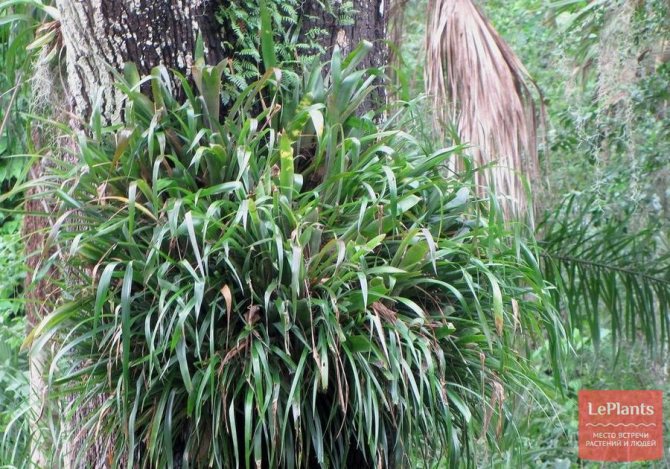

IN THE PHOTO: Bilbergia has small roots drooping, which it uses mainly for fixing on a tree, and receives nutrients and moisture through the leaves.
Description of the plant:
Plant size and type:
Bilbergia drooping is one of the most popular plants of the Bromeliad family. The leaves of the plant are collected in vertical rosettes. Plant height can reach 45-60 cm.
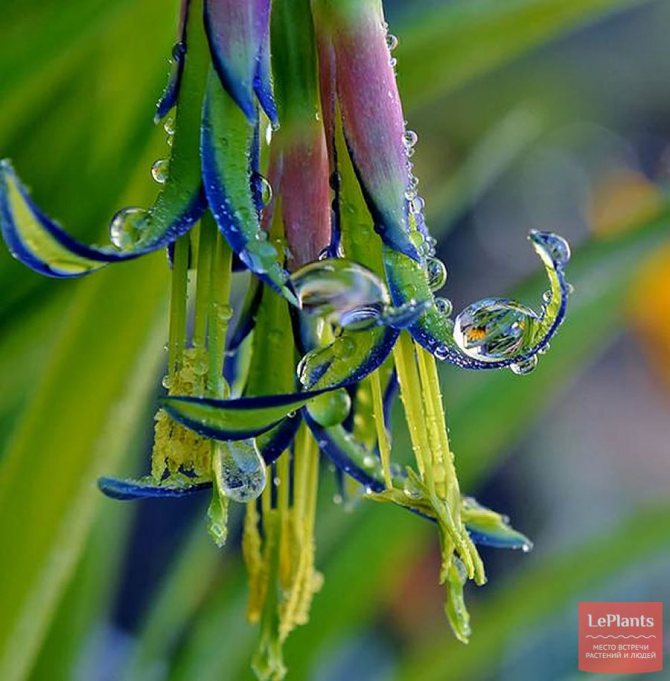

IN THE PHOTO: The popular name ‘Tears of Queens’ Bilbergia drooping received because of the drops of nectar that appear on the flowers if you touch them.
Leaves:
Five to eight narrow, rigid xiphoid leaves are collected in a tubular rosette. The upper half of the leaf blade is bent outward. The leaves are 25–35 cm long, about 1 cm wide. They are painted olive green, but in the bright sun they can acquire a reddish tint.
Flowers:
Flowers 2 cm long, drooping, pink petals with blue edges, bracts 5-8 cm long, pink. Flowers last no more than one or two weeks.


IN THE PHOTO: Bilbergia drooping begins to bloom when it reaches maturity, which usually happens after 2-3 years. Bilbergia does not have a definite flowering season; it can bloom at any time of the year.
Agrotechnics:
Bilbergia drooping is often grown as an ornamental plant. With sufficient heat, it grows all year round, without a dormant period.
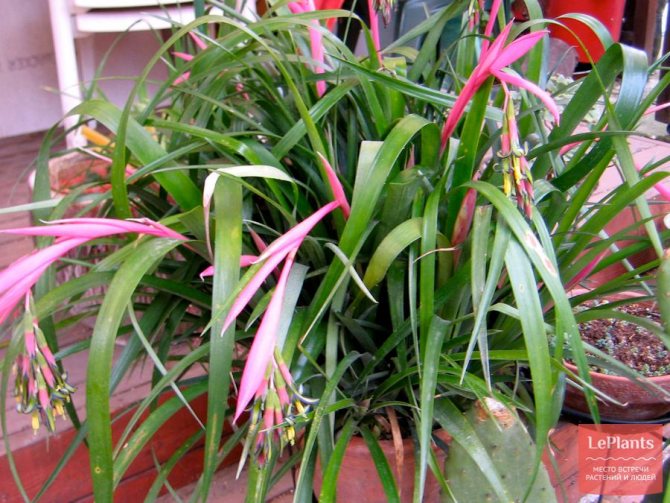

IN THE PHOTO: Bilbergia drooping is the easiest to care for from the Bromeliad family, which is easily adaptable to indoor keeping.
Temperature:
This species grows well at room temperature. Some varieties can tolerate rather low temperatures - up to about + 7 ° C.
In summer, the plant can be kept outdoors at a temperature of + 18–27 ° C.
Lighting:
Sunlight is essential for regular flowering and vibrant color of the leaves. In summer, the plant needs bright, but indirect light; direct sun can destroy the flowers. When grown outdoors, Bilbergia drooping must be slightly shaded.
Watering:
Watering should be moderate throughout the year. When watering, you need to ensure that the soil mixture is completely saturated with moisture. Before the next watering, the top layer of the soil should dry out by 1 cm. In addition, rain or soft water should always be in the center of the rosette of leaves. Once a month, the outlet must be emptied of old water by turning the pot with the plant upside down, and then pour fresh water into the outlet. It is necessary to ensure that the base of the plant is not wet, this can lead to decay of the roots.
Humidity:
Air humidity should be moderate; to increase humidity, it is useful to periodically spray the plant. In autumn, winter and early spring, Bilbergia drooping should be sprayed every few days and watered carefully so that the soil is slightly moist.
Fertilizer:
In the summer, Bilbergia should be fed regularly, about once every two weeks, with standard liquid fertilizer. Moreover, it is necessary to apply not only root, but also foliar dressing, spraying the leaves and pouring fertilizer into the recess in the center of the outlet. The rest of the time, feeding is reduced to once a month.
Substrate:
Bilbergia drooping is the least demanding on the substrate compared to other members of the family, it grows well both in standard soil for Bromeliads, and in a mixture of equal parts of garden soil and leaf humus, as well as in a mixture of one part of garden soil and two parts of perlite or tree bark. Good drainage is essential. This plant does not have a very developed root system, so the pot should be relatively small.
A pot with a diameter of 13 cm can accommodate several rosettes, but a single specimen with a tall tubular rosette looks better.
It is preferable to use heavy clay pots, plastic ones can tip over. Young Bilbergia, if necessary, is transplanted into a pot one size larger every spring. You need to divide the plant every few years.
Diseases and pests:
Bilbergia drooping is not affected by pests.
If a mature plant does not bloom, it may be due to insufficient lighting.
To solve the problem, you need to rearrange the pot to a brighter place. You can also add a pinch of magnesium sulfate to water or fertilizer to stimulate flowering.
The brown tips of the leaves are the result of dry air.
Although Bilbergias are more tolerant of dry air than other Bromeliads, occasional spraying will benefit the plant.
Reproduction:
This plant propagates by offspring, but they need to be separated after they reach a length of 10-15 cm and take on the characteristic features of the mother plant. Very small offspring rarely take root. The offspring are planted shallowly in small pots filled with soil for Bromeliads, trying to preserve all the roots, if any, and put in a moderately bright place.
Sometimes it is necessary to use a thin peg to support it until the young plant has enough roots to stand on its own.
The soil mixture should be slightly damp, between waterings its top layer should dry out by 2–5 cm. Rooting usually takes place within eight weeks, after which the young Bilbergia is looked after as an adult plant.
Transfer
Bilbergia needs rare transplants. It has a weak root system, so it is worried only in extreme cases.
Transplants are necessary for young plants that require replacing the pot with a larger one. For adults, a transplant is enough once every 2-3 years or more.
There are several main signs indicating the need to transplant indoor pets:
- The plant is cramped in a pot. Roots appeared in the drainage holes of the pot.
- The appearance of a moss bloom on top of the soil, its acidification.
- Decay of stems or roots.
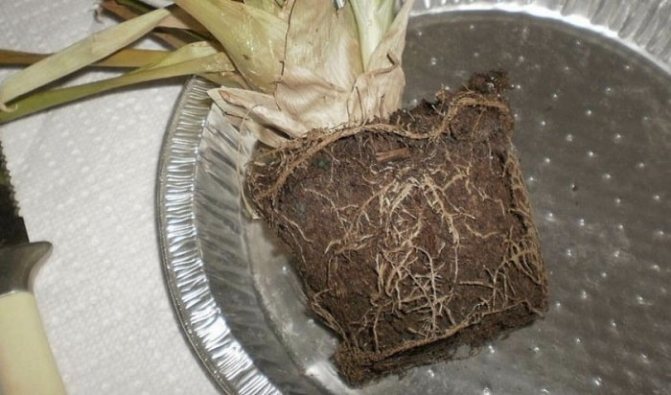

Transplant from a cramped pot
Work should begin with the disinfection of the future container.If this is a new pot, then soak it for a couple of hours in water or a weak manganese solution. And used containers need to be dealt with more carefully:
- pre-rinse with hot water;
- hold in a weak solution of superphosphate to neutralize lime residues on the pot;
- immerse for 1-2 hours in a solution prepared from 200 g of copper sulfate and 10 liters of water.
To provide air access to the roots, the bottom of the pot is filled with drainage: pebbles, expanded clay, pieces of foam.
The plant is carefully removed from the previous container, the roots are examined. If they are healthy, then the earthen lump is not completely destroyed, but transferred to a new pot. Rotten roots are cut off.
The required substrate is a ready-made substrate for bromeliads or orchids. If you cook it yourself, then you need to take garden soil, peat and leaf humus in the same ratio. Do not forget to disinfect it (fry in the oven or pour boiling water over it).
Containers for bilbergia are selected wide and not too deep.
Soil for Bilbergia
In fact, you can plant a houseplant Bilbergia in almost any soil. The main qualities that it should have are sufficient looseness, moisture conductivity and ventilation. However, it is much easier than trying to prepare a suitable soil mixture for yourself, conjuring with ingredients, will go to the store and buy a universal soil. The chances that it will not fit the flower of Bilbergia tend to zero. However, if you still crave to create, you will need to mix several types of soil (peat, coniferous and leafy), and also add humus, sand and a little charcoal to retain moisture. And, of course, do not forget that this plant, like air, needs a solid drainage layer.
Diseases and pests
Bilbergia can be attacked by pests such as aphids, mealybugs, spider mites or scale insects. Such insects can multiply on the leaves, on both sides, while yellowness appears on the greenery, and the plant dies off. For prevention, it is necessary to actively monitor and inspect the plant. Insects can be removed with a soapy sponge or cloth.
If the lesion is significant, then it is necessary to process it with special means, that is, actellik and karbofos. To obtain a solution, the funds are diluted in one liter of water with about 20 drops. All lesions must be noticed in time, otherwise the bushes will die.
Bromeliad Houseplants
Lighting
Bilbergia flower is one of those plants that cannot live without light. However, direct, baking sunlight should be avoided, because the light that this plant loves must be diffused. Therefore, the western or eastern windows will be the ideal place for planting Bilbergia. Placement, both on the northern and southern sides, is highly undesirable, since there simply will not be enough lighting on the first Bilbergia, but on the second there will be too much hassle in order to shade the plant every day at noon.
Growing bilbergia from seeds
To grow bilbergia from seeds, you must adhere to the following rules:
- Seeds are sown immediately after harvest.
- Before sowing, the seeds are disinfected in a light pink solution of potassium permanganate.
- Sowing is carried out in a mixture of peat and crushed sphagnum moss.
- The sowing container must be covered with foil and placed in a darkened, warm place with a temperature of at least + 23 °.
- The greenhouse must be ventilated periodically.
The first shoots appear in 1-1.5 months. After the seedlings form 2-3 true leaves, they dive into separate pots. In the future, they are looked after in the same way as for adult plants.
Short description
Bilbergia is an epiphyte, that is, it lives on other plants. In the wild, she prefers to live in tropical rainforests.Like other bromeliads, it is a herbaceous perennial, but in all other respects it is a completely atypical representative of the family. But it is very unpretentious - caring for drooping bilbergia is absolutely uncomplicated, and perhaps that is why they love to acquire it so much to decorate their home. By the way, it is believed that bilbergia brings harmony to the house.
Bilbergia drooping differs from other plants also in that it does not bloom in summer, like the vast majority, but in the cold period - from October to January. Thus, it seems to warms its owner in the most persistent and severe frosts, gives warmth and a reminder of a hot, colorful summer.
Top dressing
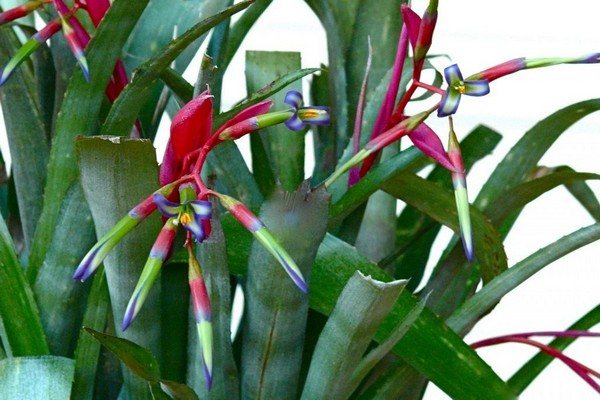

Bilbergia flower: photo
You don't need to fertilize Bilbergia too much. Maximum - only once every two weeks during the growing season. There is also no need to select a suitable fertilizer: it has long been selected for you, because there is a special complex feeding for bromeliad plants. However, fertilizer for ornamental plants of all species and families is also suitable for Bilbergia. However, there is also a very important rule: what dosage would not be indicated on the package, always pour out only half of the proposed amount.
It is also important to ensure that the fertilizer used does not contain too much nitrogen. In large quantities, it is very harmful to Bilbergia.
How to transplant and propagate bilbergia
The Bilbergia transplant is done when it has already grown out of its pot. It is easier to take a low, but rather wide capacity. It is believed that Bilbergia needs an annual transplant. It's too much. It is enough to transplant only once every couple of years, when the shrub grows up or in urgent need. For example, a pot fell and shattered.
If you are growing Bilbergia for the first time, buy a ready-made mixture for this variety and do not experiment with soil. Despite the unpretentiousness of the plant, it loves special soil.
You can try making the mixture yourself. In one container, mix ordinary (leaf) soil, finely chop the moss, pick up fine sand and take a little peat. Material ratio 2: 2: 1: 1. Mix everything thoroughly and you can plant a shrub in this soil.
The easiest way to propagate the plant is by dividing the bush. A flower transplant, as well as its reproduction, is easier to do in March, while the plant is just waking up. If you do this, then there is a chance to see how the shrub blooms this year.
How to propagate Bilbergia?
As already mentioned, the fastest and most effective way to reproduce Bilbergia is propagation with the help of shoots. A decent amount of them grows on the mother plant, and therefore you will have plenty to choose from. After selecting, cutting and planting a seedling, at least two more years must pass before it begins to bloom. However, most often this number is equal to three years. Also, as mentioned in the last paragraph, adult Bilbergia can be quite divided, having received two so-called delenki, which will have to bloom next year.
You can also propagate Bilbergia by seeds, but this method is very time consuming, effortless and has the lowest percentage of effectiveness. So you can use it exclusively as an experiment.
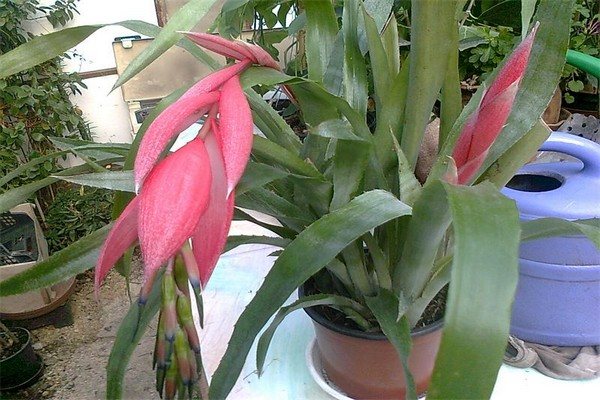

Reproduction of bilbergia by lateral processes
The easiest way to reproduce. In the process of growth, bilbergia forms numerous lateral shoots that can be used for reproduction. They are separated during the annual transplant. The larger the cut, the faster and easier they take root.
After separation, the cut sites are treated with charcoal powder. Young plants are planted in adult potting mix in small greenhouses. You can also root in crushed moss or perlite. In this case, after the development of the roots, an additional transplant into a full-fledged substrate will be required.
In conditions of high humidity, plants take root much faster.To stimulate the development of roots, the delenka can be dipped in Kornevin powder before planting. They bloom after 2-3 years of cultivation.
Pests and diseases of Bilbergia
Despite the fact that the plant is resistant to diseases and insect exposure, there are parasites that spoil plants. If detected in time, they do not pose a serious threat.
Shield
This aphid can be found on leaves from the inside or outside of the plant. Affected shoots turn yellow and gradually die off. Fighting a pest is easy. This requires a solution of the drug Actellic, sponge and spray bottle. It is prepared simply: 20 drops of the drug are dripped into a liter of water. Moisten a sponge in this solution and remove all found pests. Next, you need to spray all the plants with a solution. Usually, in 1-2 procedures, the pests disappear completely.
Mealybug
This parasite eats leaves and leaves its secretions on them. A soot-like fungus settles on them and multiplies quickly. The damaged plant will be weak, will lose its decorative effect, the leaves will turn yellow. If nothing is done, the plant will quickly die.
You can get rid of the pest using an integrated method. First, wipe the whole plant with a sponge moistened with alcohol or a solution of laundry soap. Then you need to spray it with Actellik, or another chemical agent against pests of indoor flowers. If you have done a good job, and there are no pests left on the leaves, then one procedure will be enough.
Red spider mite
This pest can live on either side of the leaves. The affected shoots are all shrouded in cobwebs, turn yellow and lose their qualities. The plant grows very poorly and also looks good. If left untreated, the tick kills the plant in 1-2 months.
Getting rid of it is easy. You must first collect the cobweb, then treat the leaves with a solution of ordinary soap and spray it with Deciss from a spray bottle. Treat the plants regularly and there will be no problems with the tick.
Aphid
It occurs due to a violation of the watering regime and settles on the leaves from above. Insects feed on bush juices. As a result, the nutrients obtained from the roots are not used for the development of the bush, but for feeding the aphids. The parasite larvae grow rapidly and grow into new pests.
As a result, it sucks out all the juice from the shoots, the leaves turn yellow and die off. The situation can be changed by removing all pests with a sponge and soap and treating with Actellik solution. The solution is prepared as in the case of the shield. For one liter of water, take about 20 drops of the drug and mix. Spray the bush with the resulting solution.
Watering
Irrigation of bilbergia drooping, living in a pot, depends on the season. If this is summer, then a lot of water is required - so much so that the soil always remains slightly wet; however, it is important to ensure that no moisture stagnates. During this period, water is sent to the funnel of leaves. Important: after flowering, it is strictly forbidden to do this, since such an action can lead to rotting of the plant. In winter, the tropical beauty is watered less often, the earth is allowed to dry, and the leaves are left dry. Water for irrigation at any time of the year should be warm, settled for a day (it is permissible to add acetic or citric acid to soften it).


If Bilbergia lives on a bromeliad tree, then all you need to do is remove the moss when it is completely dry and immerse it in a vessel of water for about twenty minutes. After this time, the moss is pulled out, the excess moisture is allowed to drain and the sphagnum is returned to its place.
Frequently Asked Questions
1) Withering leaves indicate a violation of the watering regime. If watering is done correctly, the heavy substrate is the cause of the lethargy.
2) Loss of color and pallor of the leaves indicates a lack of sunlight. It is necessary to adjust the light level.If alocasia has been in the shade for a long time, then it is gradually taken out to a lighted place. In winter, the plants must be illuminated with a fluorescent lamp.
3) The brown tips of alocasia leaves are an indicator of a violation of the air humidity or poor watering.
4) Dark spots on the leaves indicate hypothermia or exposure to a draft.
5) Small and ugly leaves are an indicator of insufficient lighting.
6) Yellowing of the tips of the leaves of alocasia indicates the use of excessively hard or chlorinated water to water the plant. Also, it may indicate an excess of nitrogen or a lack of nutrients.
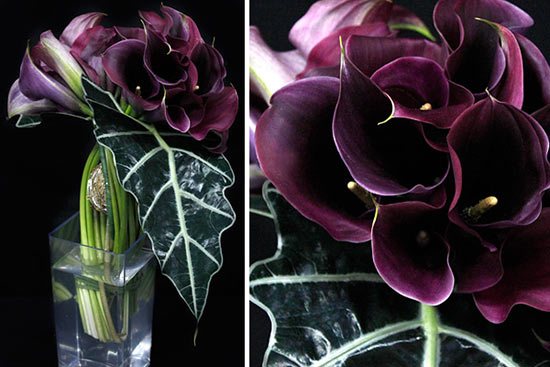

Alocasia (Brazil)
Tags: Bilbergia, Brazilian, growing, indoor, care, flower
About
«Previous post
Plant varieties
Four types of bilbergia are considered common:
- pyramidal;
- drooping;
- gorgeous;
- green-colored.
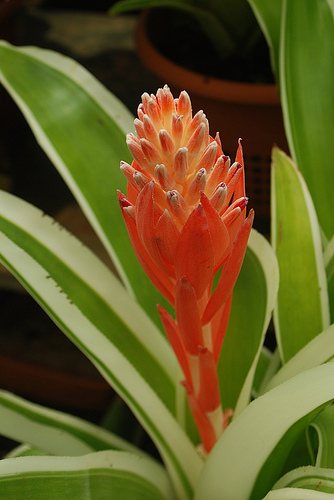

Spike-shaped flower of bilbergia pyramidal
The leaves of all species are of the same shape, they form a funnel-shaped rosette, the inflorescences are bright pink (except for the pyramidal ones - they are dark red in it). The differences lie in flowering time, habitat (divided into terrestrial and epiphytic).
Humidity
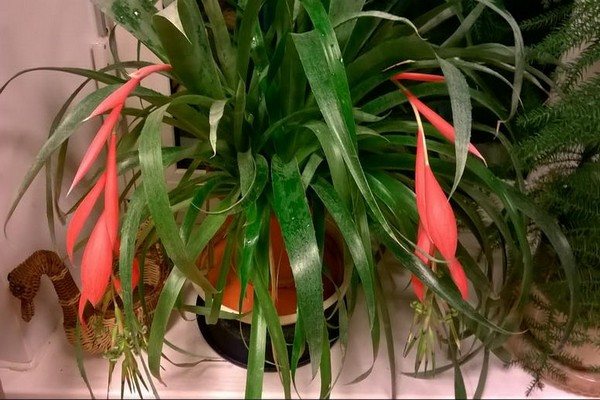

Bilbergia: photos
Humidity is a very important factor when growing Bilbergia, if you want it to produce beautiful flowers and not get sick, of course. Moreover, there should be really a lot of moisture: at least seventy to eighty percent. Therefore, an ordinary sprayer will become an extremely useful acquisition. Although, if for some reason you cannot or do not want to purchase it, you can spray Bilbergia from a spray bottle. This is also a necessary procedure when the air temperature is too high.
However, there is also a period when it is completely undesirable to moisturize Bilbergia. It is the period of flowering, when a drop of water accidentally falling on the petal can cause dark spots on it, which, of course, is completely undesirable.
Useful properties of bilbergia
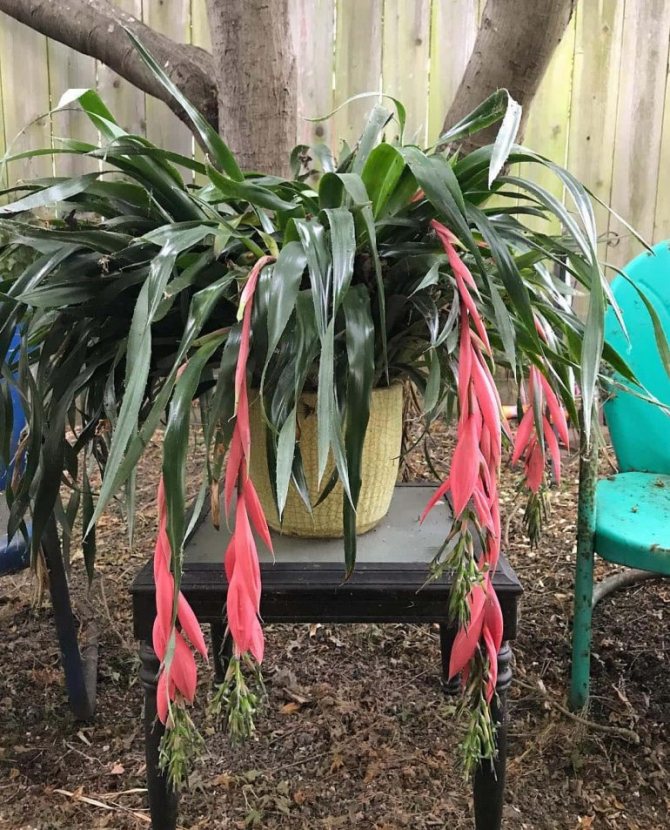

Bilbergia drooping. Photo
Bilbergia leaves actively emit phytoncides, which effectively disinfect the air. Also, the plant is able to increase the negative ionization of the air, thereby creating healthy electrostatics. In addition, bilbergia actively promotes sound absorption. And its striking appearance serves as an excellent decoration for interiors of any type.
What difficulties can there be with bilbergia?
The plant will grow healthy and bloom profusely if you follow the rules of caring for it. It is worth taking it out in direct sunlight, and the shoots will get burned. They appear as brown or rusty spots.
If the plant is watered a lot, it can also die. Basal rot develops, shoots rot. When you are about to replant a plant, be mindful of the ground. The soil for planting is prepared either according to the recipes written above or bought in the store.
Taking care of the plant is easy. If you leave for a week on business, and there is no one to look after the flowers, during this time the shrub will not die. Bilbergia tolerates a little dry air and a temporary lack of water, but put the container with it in a bowl with wet grass or moss. Bilbergia generally perfectly adapts to the domestic climate, rarely gets sick and will beautifully complement your interior design.
The soil
As for the soil, there are no special claims here. The main thing is that it is crumbly enough so that water and air can penetrate well through it. There are special soils for bromeliads, which can be used for planting bilbergia (pictured).
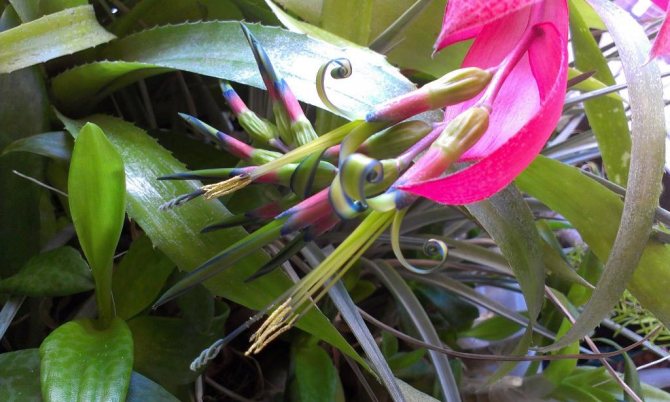

Caring for her, as you can see, is not too burdensome. And in response to the care and attention, the green pet will certainly delight the owner with original inflorescences.
However, back to the soil.According to experienced flower growers, self-preparation of the soil is also permissible: you need to proportionally mix the leaf, peat, humus, add a little chopped moss and sand. The drainage layer of the substrate must be very good.
How to grow
We are used to the fact that all indoor plants live in decorative pots, and this is logical. However, do not forget that bilbergia is an epiphyte that settles on other trees, as well as just snags. Therefore, you can plant this flower on the so-called bromeliad tree - in other words, on a large branching snag. It is not difficult to place bilbergia there: you just need to pull the flower out of the pot, clean the roots from the ground, wrap it in sphagnum moss, and then tie it to the snag. There is only one drawback of this arrangement - the tree is still quite impressive in size, so the room where it will be located should be quite spacious. However, this drawback can be circumvented: in small rooms, instead of a tree, a small block of wood is simply attached to the wall. It looks quite impressive, and caring for bilbergia in this case is reduced solely to maintaining the moisture of the moss in proper form.
Pests
Alocasia can be attacked by thrips, scale insects, red spider mites and mealybugs. The defeat can occur against a background of too high a temperature or too dry air.
The affected areas of the plant are wiped with a soapy sponge, and in case of severe damage, a solution of actellik is used, or one of the plant-based preparations.
Bilbergia flower is a tenacious plant that has strong immunity, but a systematic violation of the rules of home care leads to a weakening of health. In this state, tropical epiphytes become an excellent target for diseases and parasites.
In bilbergia, diseases of a fungal nature appear in moist soil when it is cold (below 14 C) and a lack of light. The peak of activation falls on the autumn-winter period, the beginning of spring. Preventive care measures are more reliable than treatment, therefore, they irrigate the flower with a fungicide once a month.
At home, insects run over from infected flowers and attack weakened specimens. The parasites feed on the intercellular sap of the foliage, which leads to a loss of decorativeness, the death of greenery. The bilbergia flower is attacked by:
- spider mite;
- mealybug;
- shields;
- aphids.
If the invasion is insignificant, then folk remedies will do. The epiphyte leaves are manually wiped with a sponge dipped in soapy water. If the lesion is extensive, it is not worth experimenting, therefore, the "patient" is treated with Aktellik complex insecticide. To improve the condition, experts recommend alternating procedures with Epin sprays.
Bilbergia flower is a beautiful plant that will be a great addition to the interior. An undemanding culture will withstand the mistakes of home care. If you do not violate the rules of agricultural technology, then a gentle tropical guest will delight the owner with spectacular buds
Air temperature
This plant is not particularly whimsical to the temperature at which it will have to grow. However, there are still optimal standards and it is advisable to adhere to them. The life cycle of Bilbergia is divided into a growing season and a dormant period. So, during the growing season, there are practically no frames limiting the temperature of the room in which Bilbergia grows. However, there are standards, and they say that the optimum temperature for this plant is between twenty and thirty degrees Celsius. However, during the rest period, the recommended temperature serves up to almost fifteen degrees. This period cannot be neglected, since it is during this period that the kidneys develop most actively in Bilbergia.
Nevertheless, the houseplant Bilbergia also withstands critically low temperatures quite well: up to two to three degrees Celsius. It also copes well with drafts and is practically not afraid of them.However, Bilbergia will not be able to survive at such a temperature, which lasts for a long time. Even if the plant does not die, it will definitely get sick. The exact same effect will be observed at temperatures below thirteen degrees.
Bilbergia Sanders plant care and description
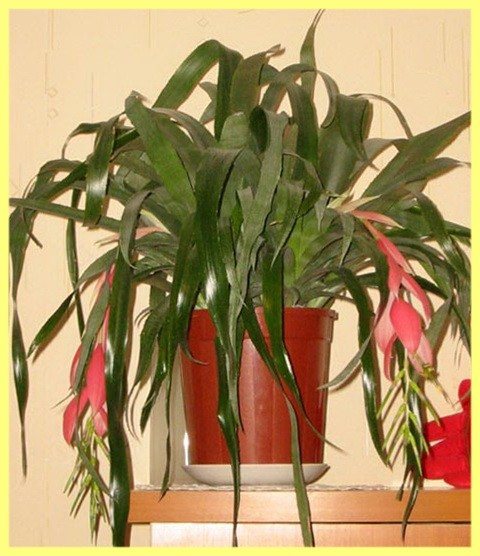

A small plant that has 4-6 elongated leaves that grow in a rosette. On one side, the leaves are green with a slightly bronze tint. On the outside, they are brownish-red in dots, stripes, specks of yellow, pink and orange.
When you look at a plant for the first time, it seems that someone spilled paint on it. The leaves of the Sanders variety do not grow more than 30 centimeters in length. On the sides they have brown spines. Flowers at Bilbergia Sanders look like spikelets of green-yellow color with bluish specks. They sit in scarlet flower beds. The plant looks very beautiful and bright.
The variety is propagated by "children" and cuttings. This flower is susceptible to disease. Most often it is affected by root rot, therefore, special attention is paid to the temperature regime in the room and the frequency of watering. Among insects, Bilbergia is loved by spider mites, mealy worms and scale insects. There are Sanders varieties with red, yellow or blue flowers.
How to feed bilbergia and how
You need to feed the plant so that it blooms well. But, you can easily overfeed and the bush will burn. This is especially true for nitrogen. Buy fertilizers that are made specifically for bromeliads like Bilbergia.
You can take fertilizers for all flowering plants. They are sold in universal packaging. But, never use the entire dose written on the package. Only 50% of the mixture is enough for one feeding. Carry out the work after watering the plants. You can only fertilize a flower when it grows and is about to bloom. Additional nutrition will result in beautiful flowers, rich in color.
Types and varieties
The rich palette of plants has expanded significantly thanks to the efforts of breeders. Even at the amateur level, breeding helps to learn the mysterious world of plants, to study the subtleties of agricultural technology more deeply and to fully manifest your creativity. The creation of at least one new variety is aerobatics for a florist.
Popular types of bilbergia.
Bilbergia saundersii


Bilbergia saundersii
Bilbergia Sanders is an epiphytic culture. Olive leaf plates with a bronze sheen, underneath painted in a reddish-chocolate shade. The flowers are lemon green with an azure tint at the tips of the petals.
Bilbergia drooping (Billbergia nutans)
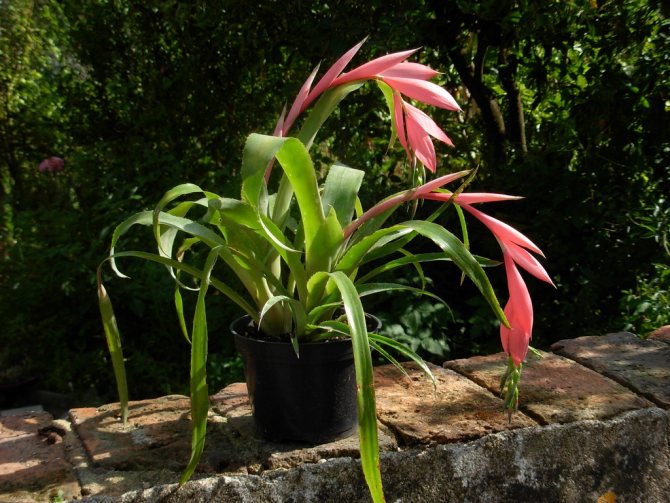

Bilbergia drooping (Billbergia nutans)
Among modern flower growers, Bilbergia drooping, which settles on other plants, is popular. It blooms in winter, which is why this species is often called the "Christmas flower". The inflorescence resembles oats in shape, this feature gave the plant another name - "Chinese oats". Bilbergia drooping is a common and unpretentious species. The plant forms a funnel-shaped rosette of narrow, prickly long leaves, from the center of which a tall peduncle with an inflorescence grows.
Several years pass before the first flowering begins - bilbergia takes a lot of time to fully develop.
After flowering, the mother rosette rests and is replaced by lateral shoots growing at the base. The attractiveness of the inflorescence of bilbergia is given by the spectacular bracts that turn pink with proper lighting. The flowers themselves are small and not too expressive.
Bilbergia pyramidalis
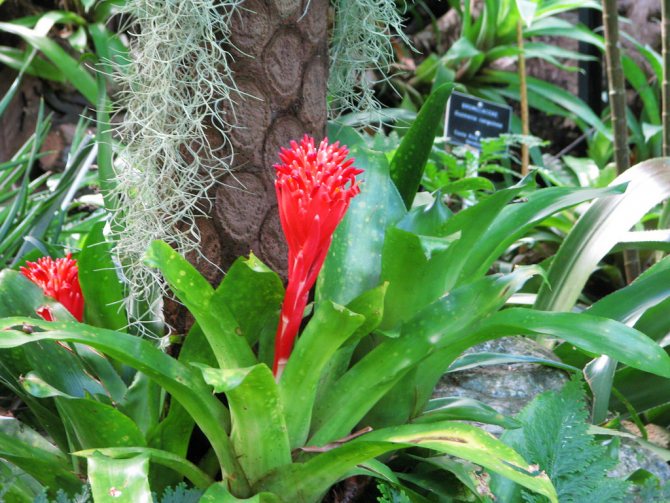

Bilbergia pyramidal (Billbergia pyramidalis)
Bilbergia pyramidal is a terrestrial species with a small number of pointed bright malachite wide leaf plates. The inflorescence is pyramidal. The flowers are crimson, growing on short stalks. Flowering time: April to August.
Bilbergia Ventus


Bilbergia Ventus
Representatives of this species have pink flowers.
Bilbergia magnifica
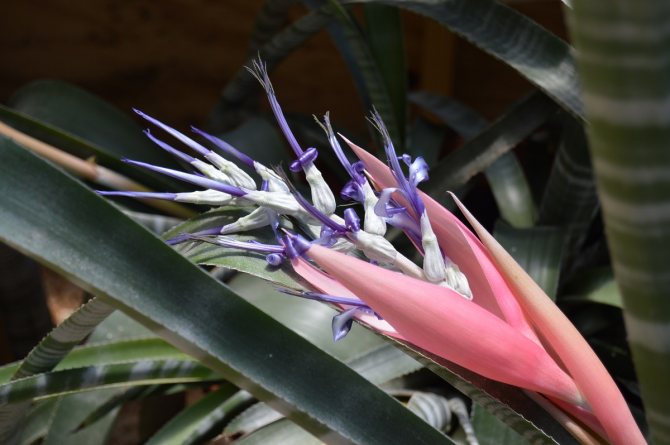

Bilbergia magnifica
Bilbergia is magnificent - an epiphytic plant. Olive striped leaf plates are covered with a slightly noticeable downy. The inflorescence is soft, lowered, with an axis covered with tiny hairs. The plant blooms in summer.
Bilbergia green-flowered (Billbergia viridiflora)


Bilbergia green-flowered (Billbergia viridiflora)
Bilbergia green-colored is a voluminous epiphyte plant with a dense rosette. Inflorescence petals of a tobacco shade. Flowering time: early spring, last summer days.
Bilbergia zebra (Billbergia zebrina)
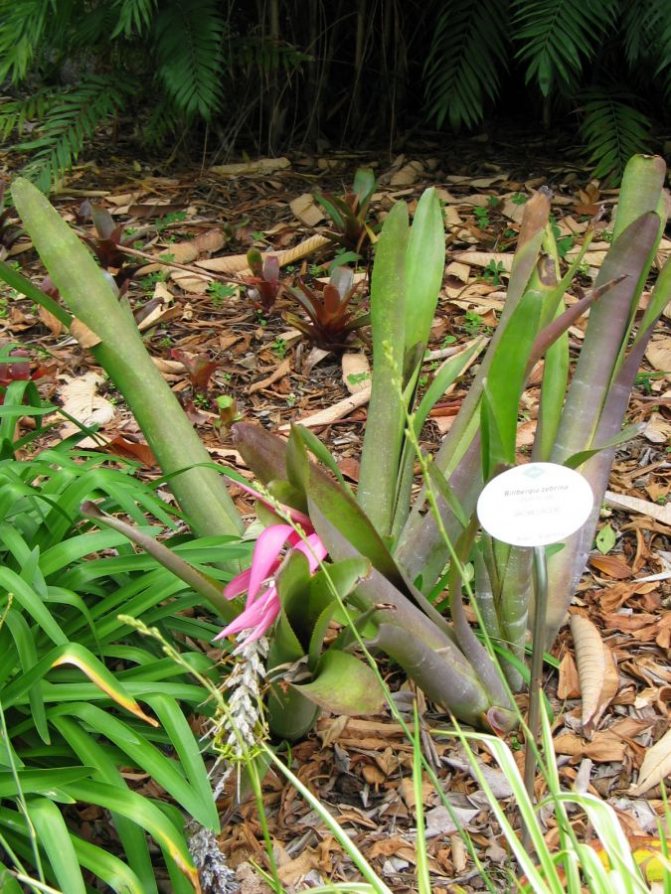

Bilbergia zebra (Billbergia zebrina)
Bilbergia zebra is a plant whose leaf plates have a carmine-golden tone, as if scorched by the sun, with smoky transverse stripes. Peduncle pearlescent, pinkish, bracts of bright strawberry color.
Bilbergia tape (Billbergia cohors)
Representatives of the species are similar to zebra-like bilbergia. The leaf plates of Bilbergia ribbon are distinguished by an elegant color: from malachite to bronze, with smoky stripes on the back. The flowers are dark azure on a light pink peduncle.
Bilbergia photos
Care difficulties
- The appearance of light brown spots on the leaves indicates too bright lighting. The plant must be rearranged in a slightly shaded place.
- With too much moisture, or watering with hard water, the tips of the leaves become dry and brown.
- Another symptom of over-watering is the death of young rosettes of leaves on plants that have not yet bloomed.
- If a loose outlet is formed, or it falls to the side, it is necessary to increase the lighting.
- Yellowing of leaves and dying off, speaks of pest damage.
Special recommendations
- Two months after flowering, the old rosettes of leaves are carefully removed. This makes it possible to do without a transplant for a long time.
- In one container, you can combine different types of bilbergia, as well as combine with other types (sansevier, scindapsus, ivy). This way you can create unusual decorative compositions.

